

Dog-Friendly Victoria: Holidaying in Victoria with a Dog
Victoria is one of the best states in Australia to holiday with a dog, whether you’re originally from the state or just passing through on a road trip. In my experience, Victoria is a very dog-friendly state, with plenty of things to do with your pup.
Whether you’re looking for ideas for your next weekend away with your dog, or are putting together a bucket list of everything you want to do in the state, check out my list of holiday ideas, plus my guides to specific towns and regions of Victoria.
Start planning your dog-friendly holiday in Victoria…
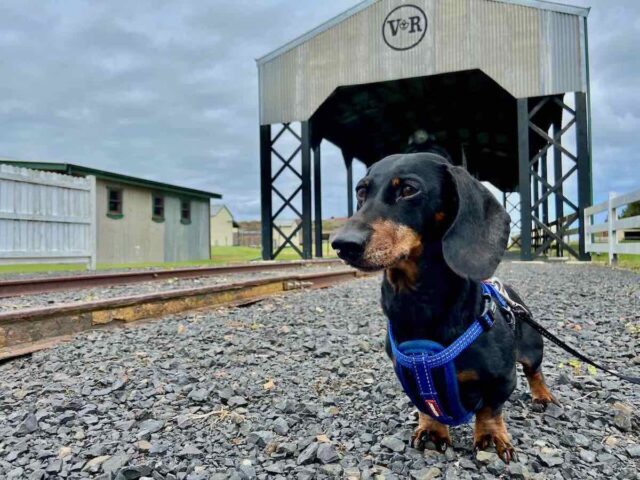
Dog-Friendly Accommodation in Victoria
There’s a wide variety of dog-friendly accommodation in Victoria, whether you’re looking for a city hotel, a luxury stay in the countryside, a pet-friendly caravan park to park your van or a dog-friendly campsite by the beach. Check out some of my suggestions:
- Dog-Friendly Places to Stay in Victoria
- Most Dog-Friendly Caravan Parks in Victoria
- Best Pet-Friendly Cabins in Victoria
- Best Dog-Friendly Campsites in Victoria
- Best Dog-Friendly Hotels in Melbourne
Dog-Friendly Holiday Ideas for Victoria
Looking for some ideas of what to do in Victoria with your dog? Check out these dog-friendly suggestions to add to your list…
#1 Explore Inner City Melbourne
Don’t discount the idea of exploring the inner city of Melbourne with your dog. There’s plenty of dog-friendly things that you can do, from checking out the lane ways full of street art to strolling along the Yarra. In the Botanic Gardens, you can even go punting on the lake with your dog. Or hire your own boat on the Yarra.
With dogs of all sizes allowed on the trains in metropolitan Melbourne, it’s easy to get to the city centre with your dog, especially on weekends outside of peak periods. Small dogs in a carrier bag can also enjoy the free city centre trams with you.
And if you want a change from the city laneways, head a short distance down to St Kilda, where there’s dog-friendly beaches, cafes, markets and more.
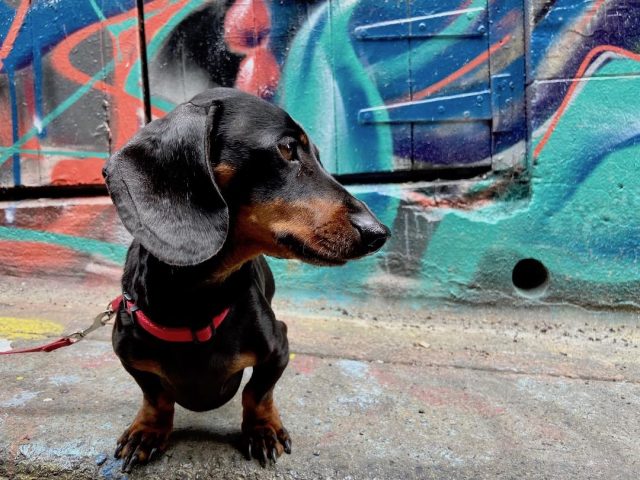
#2 Enjoy a Pet-Friendly Staycation
The Melbourne CBD is also home to some luxury hotels that have rolled out the welcome mat for four-legged guests. Rather than just visit the city on a day trip, perhaps stay for the night or the whole weekend?
Choose between a stay with your dog at the Langham, the W, the QT or Laneways by Ovolo. Note that some hotels do have size restrictions, plus direct bookings with the hotel are often required. For a full listing of pet-friendly places to stay, check out my guide to dog-friendly hotels in Melbourne .

#3 Go Wine Tasting
Victoria is home to some of the best wine growing regions in Australia. And if you’re planning on visiting some wineries to enjoy a taste and buy a dozen or two, there’s no need to leave your dog behind, with many cellar doors welcoming dogs, whether inside or at their outside tables.
Just outside of Melbourne, head north to the Yarra Valley for the day or the weekend, where there’s plenty of dog-friendly wineries, even the option to enjoy a private wine tour with your dog in style. Alternatively, head to the Mornington Peninsula , or in the High Country visit one of the wineries around Beechworth or Bright .

#4 Hike With Your Dog
There’s nothing better than skipping your usual walk with your dog and going hiking somewhere new with them for the first time. So many places to explore and smells to sniff!
While many of the most popular hikes in Victoria are located in national parks, there’s still plenty of dog-friendly hikes that you can do together, often in Victoria’s dog-friendly regional parks. For some ideas, check out my list of some of the best dog-friendly short hikes in Victoria . And if it’s been raining lately, it might be time to check out a dog-friendly waterfall !
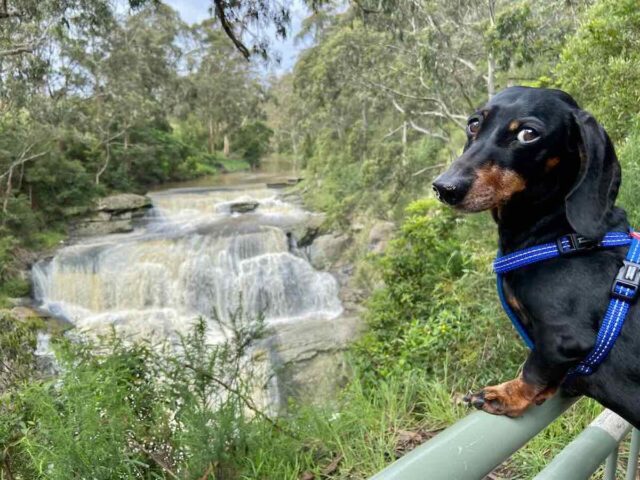
#5 Explore Victoria’s Rich History
The state of Victoria has a rich history and there’s many well-preserved historic towns and cities that you can visit, naturally with your dog at your side. Choose between gold rush cities (and ghost towns) or river ports on the Murray River.
Some of my favourite dog-friendly historic spots around Victoria include Echuca (explore the historic port precinct and take a paddle steamer ride with your dog), Bendigo (dogs are allowed on the Vintage Talking Tram and above ground at the former Central Deborah Gold Mine), Beechworth (check out the gorgeous sandstone buildings including the lock-up where Ned Kelly was held) and Walhalla (dogs are welcome on the historic trains rides and on the underground mine tours).

#6 Enjoy an Historic Train Ride
Speaking of train rides, the Walhalla Goldfields Railway isn’t the only pet-friendly historic train ride in Victoria, with the state home to many of the historic train rides that allow dogs in Australia .
If you’re interested in a different day out with your dog, also look into the pet-friendly options for the Victoria Goldfields Railway Steam Train at Castlemaine, the Daylesford Spa Country Rattler and the regular pet-friendly trips on the Puffing Billy Railway through the Dandenong Ranges.
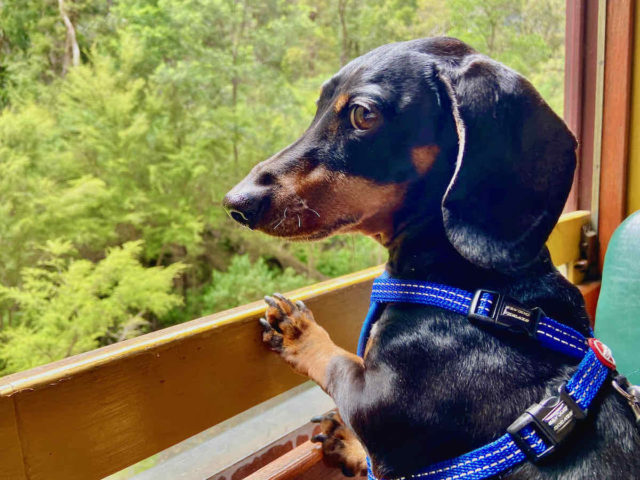
Pets on Public Transport in Victoria
Victoria is the most pet-friendly state of Australia when it comes to allowing pets on public transport . While most Australian states ban all pets from public transport or just allow pets onboard in limited scenarios (such as small pets in carrier bags on buses), Victoria frequently allows pets onboard public transport services .
The most pet-friendly public transport option in Victoria are the metropolitan trains in Melbourne. As well as small animals in a container, larger dogs wearing a leash and muzzle are also permitted, with just the recommendation to avoid peak hour (7am to 9am and 4pm to 6pm on weekdays).
It’s actually possible to leave your car behind and travel around Melbourne on trains with your dog! However, when it comes to trams and buses, only small pets in a suitable container are permitted – skip trams and buses if you have a larger dog.

If you have a small pet, it’s also possible to travel to regional Victoria using public transport. Small pets in a suitable container are allowed on the V/Line train services . Note that pet containers are required to be stored in the luggage storage area on VLocity and Sprinter trains, or the conductor van on H Set and N Set trains, with off-peak travel recommended.
V/Line trains head to destinations right across Victoria including Geelong, Macedon, Ballarat,, Bendigo, Echuca, Wangaratta and more. Check out the network map . Just make sure that you choose a train rather than coach service, and coach replacements are not in operation – pets are not allowed on V/Line coaches.
Dog-Friendly Guides to Victoria
I’ve put together a number of dog-friendly guides to Victoria, covering everything from dog-friendly beaches and walks, to guides to many of the cities and regions that we visited. For more information, check out these guides.
- Best Dog-Friendly Beaches in Victoria
- Dog-Friendly Short Walks in Victoria
- Dog-Friendly Waterfalls in Victoria
- Best Fenced Dog Parks in Victoria
- Best Dog-Friendly Gardens in Victoria
Around Melbourne

There’s plenty of dog-friendly things to do right in Melbourne and the surrounding areas, perfect for a day out or weekend away with your pup…
- Dog-Friendly Melbourne
- Dog-Friendly Days Out Around Melbourne
- Best Dog-Friendly Weekend Getaways from Melbourne
- Dog-Friendly Mornington Peninsula
- Dog-Friendly Yarra Valley
- Dog-Friendly Macedon Ranges
- Dog-Friendly Daylesford
- Dog-Friendly Geelong
Coastal Victoria
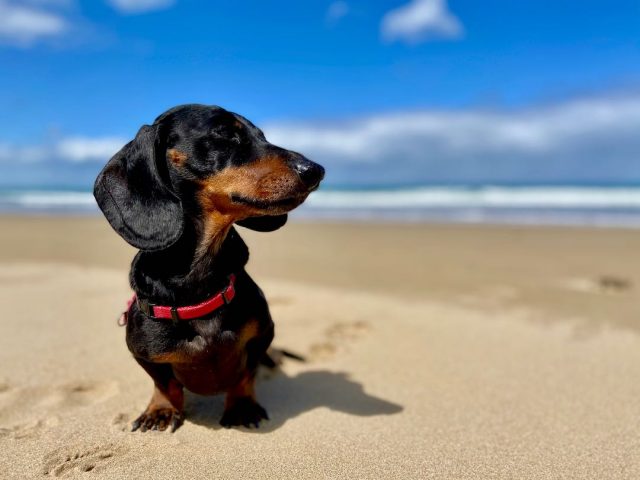
Head east or west along the coast of Victoria with your dog and check out these attractions…
- Dog-Friendly Great Ocean Road
- Visiting the Twelve Apostles
- Dog-Friendly Lorne
- Dog-Friendly Phillip Island
- Dog-Friendly Lakes Entrance
Country Victoria
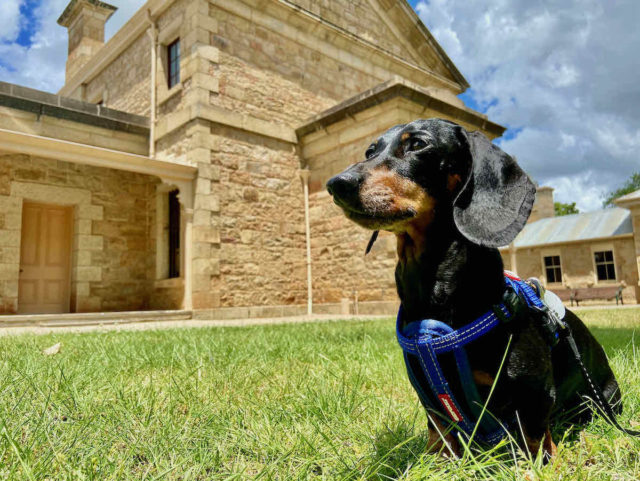
Head inland in Victoria to the countryside for plenty of dog-friendly things to do…
- Dog-Friendly Things to Do in Country Victoria
- Dog-Friendly Beechworth
- Dog-Friendly Bendigo
- Dog-Friendly Bright
- Dog-Friendly Echuca
- Dog-Friendly Mildura
- Dog-Friendly Walhalla
- Driving the Hume Highway to Sydney
About the Author

Shandos Cleaver is the founder of Travelnuity: Dog-Friendly Travel. She has travelled extensively with her Miniature Dachshund, Schnitzel, including to 33 countries across Europe, every state and territory of Australia except Tasmania, and 10 of the United States. She’s passionate about providing inspiration and information to others wanting to travel with their dogs, whether close to home or internationally.
Leave a Comment Cancel reply
Save my name, email, and website in this browser for the next time I comment.
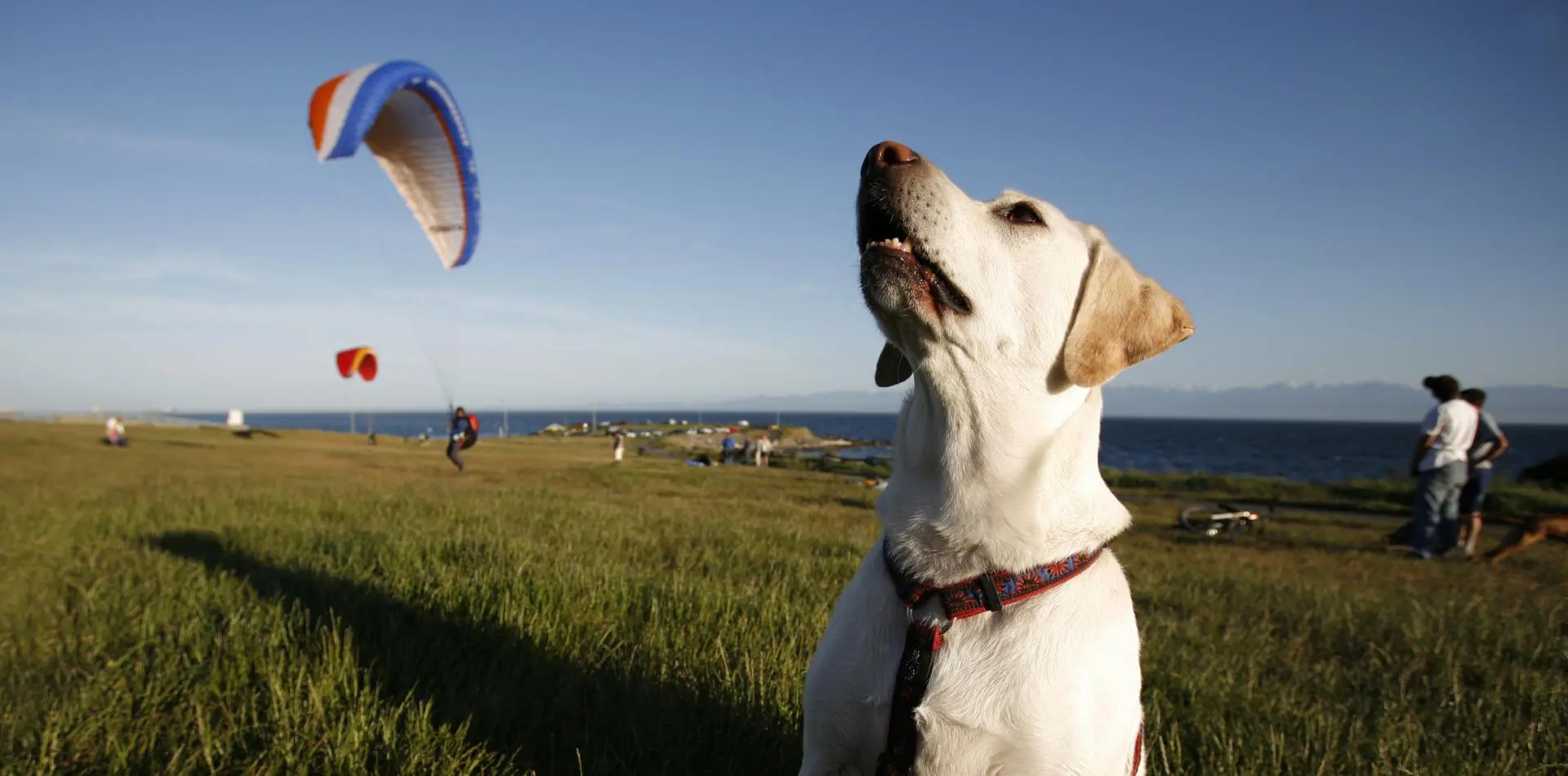
Pet Friendly Victoria: A Three Day Sample Itinerary
If you’ve got the ants in your pants for a fun-filled getaway with your four-legged friend(s), we’re letting the cat out of the bag; Victoria is the pick of the litter when it comes to pet friendly vacation destinations. An urban-rural balance like no other connects our muttropolitan city centre to a network of trails and parks waiting to be sniffed and explored. Take it straight from the horse’s mouth, with endless pawsibilities, Victoria is a pet-lover’s paradise that’s the purrfect spot for your va-cat-ion*.
RECOMMENDED ACCOMMODATIONS: CHATEAU VICTORIA HOTEL & SUITES
Stressed about finding a dog-friendly hotel? Don’t terrier self-up about it. Chateau Victoria Hotel & Suites makes visiting Victoria with your dog easy-peasy. This locally owned and operated hotel offers both dog-friendly traditional and one-bedroom suites. For a pawsitively perfect stay for your pooch, the Chateau provides doggy amenities including towels and wipes, treats, bowls and dishes, bedding and blankets, and pet waste bags. Forget cat naps, this is a stay so comfortable you’ll let sleeping dogs lie.
RECOMMENDED ACCOMMODATIONS: HOTEL GRAND PACIFIC
Just because you’re travelling with your pet doesn’t mean you have to ruff it. The pet friendly Hotel Grand Pacific provides guests with a personalized experience at their luxurious harbourfront property. This courtesy is extended beyond human customers to our furry friends as well. Pre-order your Pampered Pooch Package and treat your canine companion to a stay they’ll never forget. This $50 non-refundable fee includes a doggy-bed, food and water bowls, all natural organic doggie treats, a disposable doggie clean-up kit, and more.
The Butchart Gardens is a National Historic Site of Canada and is home to millions of bedding plants. For over 100 years The Butchart Gardens has enchanted locals and visitors alike with immaculately manicured gardens and a fairytale atmosphere that you must experience to believe. Featuring 55 acres of gardens to discover, 900 bedding plant varieties, and 26 greenhouses, The Butchart Gardens provides hours of exploration and countless opportunities to paws and smell the roses. The Gardens happily welcomes well-behaved leashed pets (though there are some restrictions during the holiday season). Click here for more information on The Butchart Garden’s pet policy.
A little birdie told me about one of Vancouver Island’s best kept secrets, Sea Cider Farm & Ciderhouse . This farm-based cidery is located on the Saanich Peninsula just a stick’s throw away from The Butchart Gardens. This breathtaking property’s 10-acre orchard and cider house overlook the tranquil waters of the Haro Strait toward James Island. When it comes to ciders, Sea Cider is the pick of the litter; their award-winning ciders are produced using organic apples grown on their onsite orchard featuring 1,300 apple trees. Enjoy a cider flight at their pet-friendly picnic area and enjoy the serene views with your fur buddy.
Mutts about the outdoors? Well, you’re in luck; Victoria’s proximity to rugged natural landscapes provides a lifetime of exploration. Grab your purr-tner and get mewving as you explore Mount Douglas Regional Park. A local favourite for taking in an incredible sunset, “Mount Doug” as it is affectionately known, is the largest urban forest on the Saanich Peninsula boasting 21km of trails. Hike, bike, or drive to the top and take in second-to-none views of Victoria, the Saanich Peninsula, the Salish Sea, and the magnificent Gulf Islands.
It’s time to grab a bite before bed, and surely by now you’ve worked up a fur-ocious appetite. Mosey on over to The Steamship Grill & Bar . Originally built in 1924, this heritage building designed by famed architect Francis Rattenbury once welcomed steamship passengers from around the world. 100 years later, The Steamship still welcomes guests from every corner of the globe, but they do it with hand-shaken cocktails and fresh caught local seafood, and best yet, they do it all on their pet friendly patio! With so many delicious options to choose from, The Steamship will leave you in need of a doggy bag. Bon A-pet-treat!
Victoria ain’t no one horse town. If you’re chomping at the bit to get back in the saddle, then Elk/Beaver Lake Regional Park is for you. Beautiful horse friendly trails hug the sides of one of Victoria’s favourite lakes and the non-profit Elk Lake Equestrian Centre is great for refining your riding skills. Elk/Beaver Lake is just one of the region’s many horse-friendly trail systems, and that’s good news for both you and the horse you rode in on.
Local Tip: Elk/Beaver Lake Regional Park isn’t just for horses. A fishing dock, multiple beaches, and a 10km circle route trail make this a great stop for families and pets.
It’s time for a pick-me-up. I don’t know about you, but when I find a hot cup of locally roasted, ethically sourced coffee, I’m like a dog with two tails. Caffe Fantastico has worked for years to establish connections with farming communities, and as a result, offers a curated coffee selection of Arabica beans. One sip of any of their fine roasts and you’ll be ready to grab the bull by the horns. Enjoy Caffe Fantastico’s hot coffee, fresh snacks, and the company of man’s best friend on their dog friendly patio, while you people watch the kitty corner.
That great coffee has given you a new leash on life. It’s time for a waterfront stroll along Victoria’s picture-perfect Inner Harbour . Our oceanside walk begins at the Victoria Visitor Centre , where we follow the steps down to the main walkway. Watch seaplanes come and go and water taxis scuttle across the still waters as you take in the views of some of Victoria’s iconic landmarks, including the BC Parliament Buildings , Delta Hotels by Marriott Victoria Ocean Pointe Resort , and the Fairmont Empress Hotel (whose Canine Ambassador, Winston, will greet you with a wag). After weaving our way around the harbour, Victoria’s floating neighbourhood, Fisherman’s Wharf , bursts brightly into view. These quirky, colourful float homes are an Instagrammer’s paradise, and offer some great culinary delights. Fisherman’s Wharf is open year round, but the open-air floating network of attractions, restaurants, and homes is best enjoyed in the dog days of summer, where bright blue skies and dazzling sunsets compliment this colourful neighbourhood.
Finding great food at Fisherman’s Wharf is like shooting fish in a barrel, but no trip to Fisherman’s Wharf is complete without a stop at Barb’s Fish and Chips . This floating chippy has been cooking, what are pawsibly, Victoria’s favourite fish and chips for nearly 40 years. Through hard work and word of mouth, Barb’s has grown into a local institution that has been voted Victoria’s best fish and chips on several occasions. Barb’s takes the haddock out of dinner preparation serving up Pacific halibut, salmon, and Fanny Bay oysters. Located on dock at the dog-friendly Fisherman’s Wharf, this is a great spot for you and your pooch to enjoy fantastic fresh fish. There’s no reason to feel gill-ty about pigging out at Barb’s, a leisurely stroll back to the hotel will help you burn those batter fried calories.
Rise and shine! I’m sure you’ve slept like a dog in your pet friendly palace. Now, it’s time to hit the trails. Victoria seamlessly blends the wonder of rugged west coast nature into the heart of a modern city. No park showcases this better than downtown’s Beacon Hill Park . Steps from must-see sights like the Fairmont Empress and Royal BC Museum , Beacon Hill offers up a world of exploration for you and your pets. Sprawling green spaces, manicured gardens, a children’s petting zoo, Gary Oaks, and gorgeous fountains are just a few of the sights that await the park’s explorers. When it comes to urban parks, Beacon Hill is the cat’s meow!
Local Tip: Beacon Hill Park boasts plentiful numbers of peacocks, squirrels, and other nesting birds, please keep your dog on a leash.
All aboard! The next stop on our four-legged tour is the Victoria Harbour Ferry Company Ltd. Zip along the calm waters of Victoria’s Inner Harbour or the Gorge Waterway taking in the sights and sounds of Victoria’s modern maritime corridor. The unrivaled views of historic landmarks and marine animals coupled with the swooping buzz of landing seaplanes will surely have you grinning like a Cheshire cat. Please ensure your dog is leashed or crated, and under your control at all times.
That was a big day on your feet, and I’m sure your dogs are barking. You want to see more of this great city, but you need to get off your feet. If you’d like to take in more stunning sights of Victoria, but your feet are getting weary, Tally-Ho Carriage Tours has got you covered. Since 1903, Tally-Ho has been recognized as one of Victoria’s iconic sightseeing experience. Let their professional guides and equine partners escort you on a relaxing, yet entertaining tour through the remarkable beauty of Victoria. The longest running historical attraction in Victoria, Tally-Ho welcomes well behaved dogs on their carriage tours. Tally-Ho treats their draft horses as family and has spent decades honing their craft and providing the utmost care for their horses, including balanced health and training to ensure they are always happy in their work. Now that’s a horse of a different colour!
*Always check with hotels, attractions, and dining providers for any additional regulations surrounding pet policies.

Download Victoria's Vacation Guide
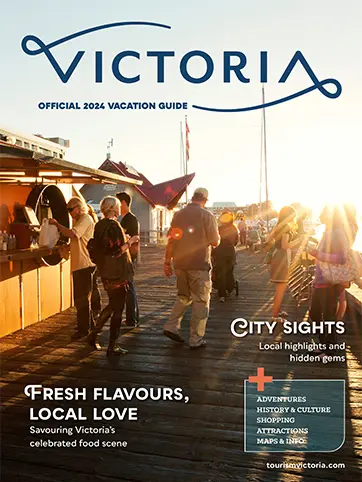
Navigate our map of Greater Victoria
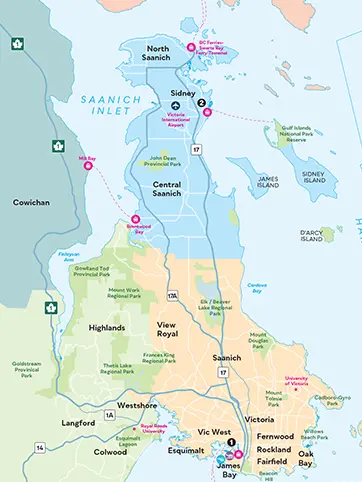
Victoria Visitor Centre
812 Wharf Street Victoria, B.C.
More Greater Victoria
- Travel Tips
Corporate Hub
- Corporate Destination Greater Victoria

- Pre-dog Preparation
- Getting a Dog
- Rescue Dogs
- Food & Feeding
- Puppy Nutrition
- Staying safe
- Understanding Dogs
- Training Tips and Tricks
- Puppy training podcast
Living with Dogs
- Travel & Adventure
- Responsible Ownership
Off The Leash is supported by Scratch
The Best Dog-friendly Airbnbs in Victoria
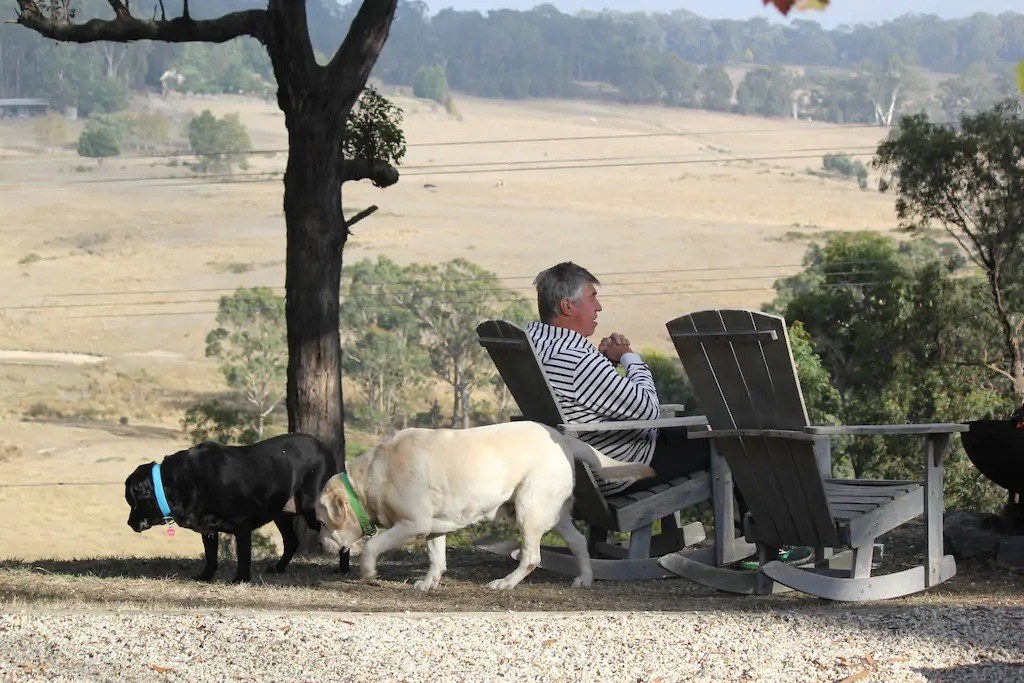
The short version:
Victorian Dog Friendly Airbnbs: With so many city, country, and coastal treats on offer, you’re never far from a good time in Victoria. Our favourite places to holiday with your dog include:
- A renovated beach house in Rye from $300 per night
- An industrial conversion in Wilsons Prom from $471.43 per night
- A private bungalow in Bittern from $136.57 per night
- An eco winery cabin in Paraparap from $172.86 per night
- A peaceful forest cottage on Mount Dandenong from $196.21 per night
There are few things I love more than a weekend getaway to a new part of Australia. The only tricky thing (apart from saving the money) is what to do with our dog?
We’ve picked out eight of the best dog-friendly Airbnb’s in Victoria for the perfect Winter getaway.
Dandenong Ranges Cottage

Great nature doesn’t come cheap in this case, but it might be worth it. This cottage near Olinda is dog-friendly. Set on 7 acres, no-one will hear your pup barking at the parrots. Enjoy the spa and cozy fireplace with someone special at a $200 per night.
See it on Airbnb .
Live Large in Rye

This is one for the architecture lovers. Right in the heart of Rye and closeby golf clubs and long beaches, your pooch can run around this beautiful timber open-plan home.
Hastings Private Bungalow

Keen to head down Mornington way and enjoy the sea breeze. This private bungalow might just be perfect and as far as nice Airbnb’s go, is pretty affordable. Set on 3 acres just near Hastings, you’ll wake to Kookaburras and Rosellas singing in the gum trees.
While you’ll be sharing this property with the main residence, your pup will make some new friends as labradors Chester and Lexie run around chasing balls. $125 per night.
A One of a Kind Eco-Cabin on the Great Ocean Road
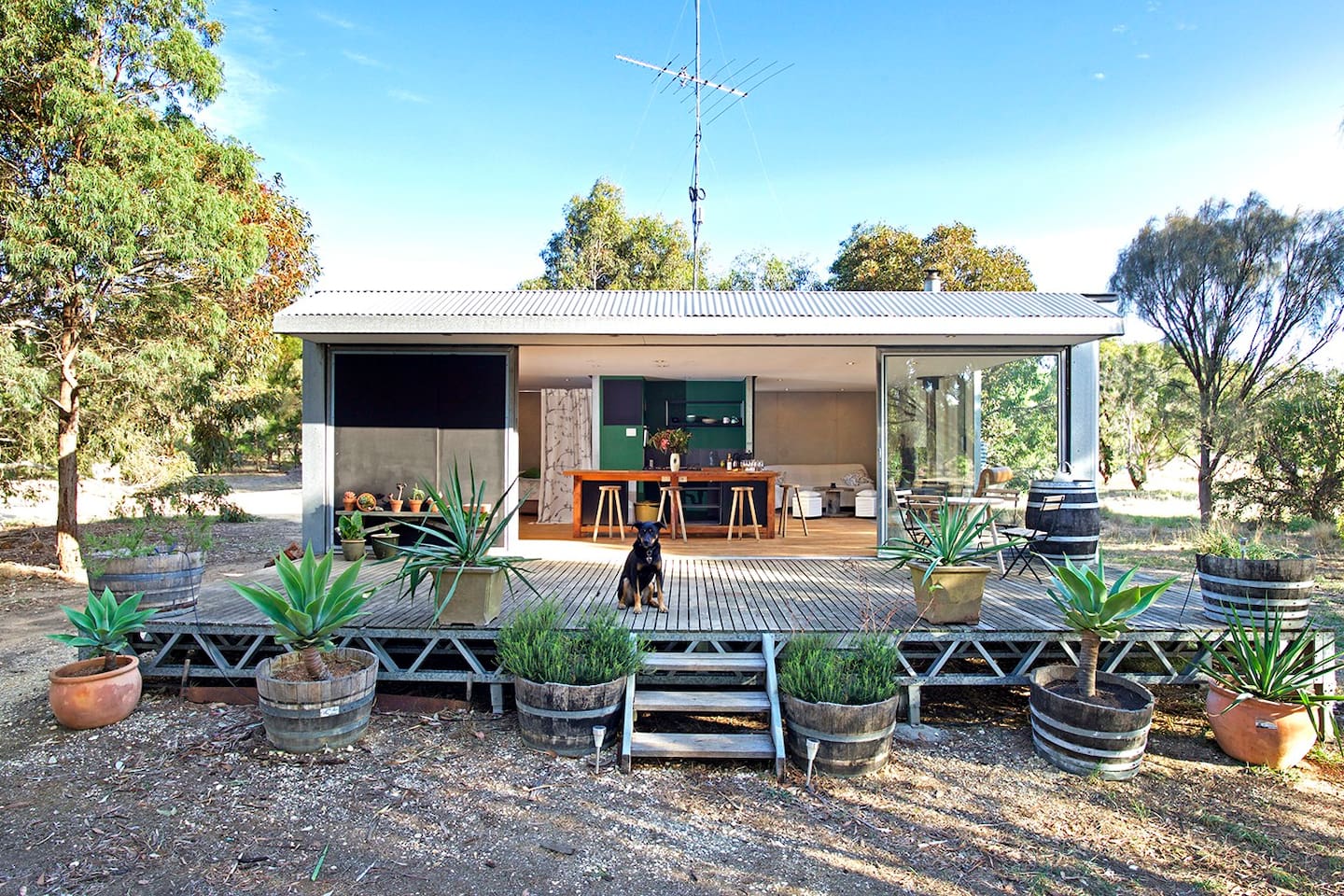
Good luck not jumping on this right away if it’s within budget. Designed by award-winning architect Simone Koch, this is the kind of shack that you’d want to cook, drink wine, throw tennis balls and generally be amongst the national park on your doorstep.
Located at the start of the great ocean road, the property is 100% solar powered and situated on the Wolseley vineyard. $190 a night.
Grab a Wine At This Woodend Studio
The Macedon Ranges area is underrated in my opinion and pretty good value for a getaway. Relax with a glass of wine on your private deck as the sun sets in front of you or light the fire pit and settle in with some toasted marshmallows and hot chocolates.
Your woofer can roam around this 5 acre property or take them for a walk nearbye in Trentham. $120 a night.
Head Towards the Mountains at Bright

After some fresh country air? Bright’s Rail Trail Cottage is just on the back of the Murray to Mountains Rail Trail. Many come up to cycle but I fancy a long walk with the dogs would go down a treat. $196 per night.
Take in the View at Wilsons Prom
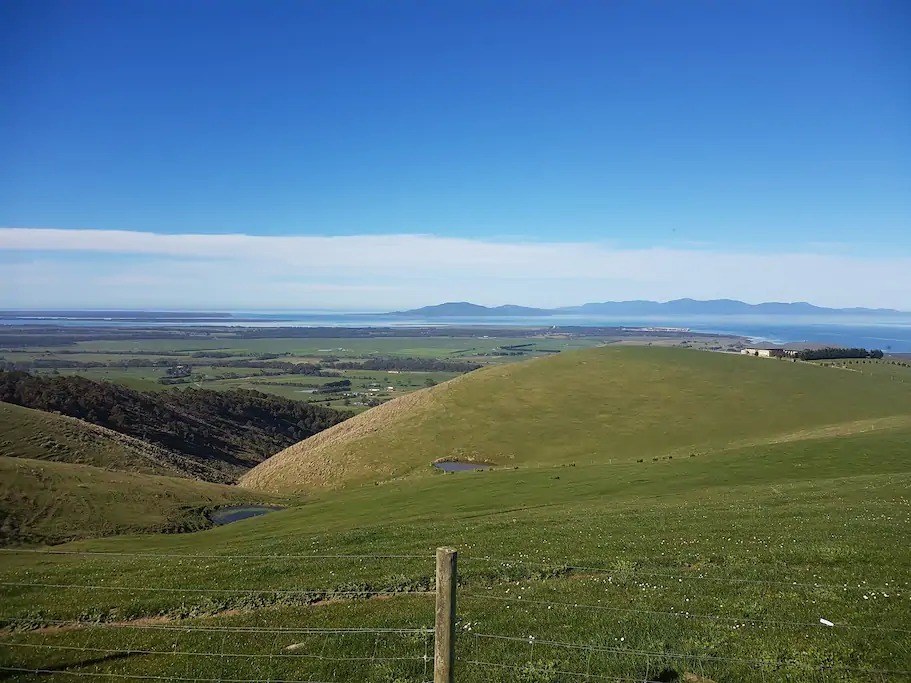
I spent most Christmas holidays camping at Wilsons Prom and can vouch for its spectacular nature. If I had my way I would have been staying at Eagles Nest, a stunning home perched on a hill with 360-degree views.
It’s a large property with a million directions to roam, so make sure your dogs know where to come back for their Scratch dinner 🙂 $230 per night.
The Barn at Glenwood Farm

After a down to earth, live on the farm vibe? The Barn at Glenwood overlooks a beautiful little valley in Macks Creek, about 160km east of Melbourne.
The cottage is close to the Tarra Bulga national park, historic Port Albert, the 90-mile beach and Wilson’s Promontory, all providing spectacular views and abundant wildlife. $170 per night.
Once you’re done exploring the dog-friendly Airbnbs in Western Australia, check out what’s going on around the rest of Australia.
The Best Dog-friendly Airbnbs in New South Wales
The Best Dog-friendly Airbnbs in Queensland
The Best Dog-Friendly Airbnbs in Western Australia

Written by Mike Halligan on April 17, 2019 for Off The Leash
Article last updated on January 13, 2021
Frequently Asked Questions
What are the best dog friendly hotels in victoria.
- Zagame’s House, Carlton
- Element Melbourne, Richmond
- Birches Serviced Apartments, East Melbourne
- Bindley House, Kilmore
- Warburton Motel, Warburton
Are dogs allowed in Victorian Airbnbs?
Some Airbnbs are dog friendly, but it’s up to the host to decide if they welcome pets. This information will be specified on their page, along with any additional conditions or costs. Bringing a dog against the host’s will could result in negative reviews, additional fees, and cancelled bookings.
Does Airbnb charge for dogs in Victoria?
Airbnb don’t have a standard additional fee for pets, but owners are able to dictate their own pet and cleaning fees. So in some cases a dog friendly Airbnb may be slightly more expensive to accommodate this.
Next in Living with Dogs

Welcome to the future: The dog-friendly office
If you or your employees have ever frothed over the possibility of bringing dogs to the workplace, you’re far from alone. Companies are introducing pet-friendliness to the employee packet in droves, from Amazon’s ‘Woof Pack’ to the #dogsofcottonon. While we don’t need to get mathematical about why dogs rock to have around, science has spoken […]
Share the post:
You might dig these.

How to Take a Good Photo of Your Dog
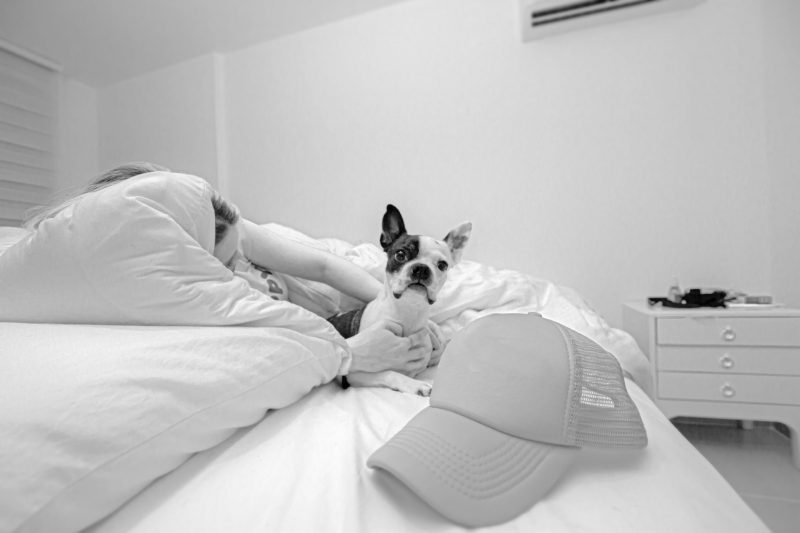
The Pros and Cons of Dogs on Beds

Are Dogs Replacing Kids in the Lives of Millennials?


Food & Drink
Arts & entertainment, design & style, travel & leisure, search concrete playground, seven of the best spots where you can camp, hike and swim with your dog in victoria.
Head out into the great outdoors with your best mate at these dog-friendly hiking, swimming and camping spots around Victoria.
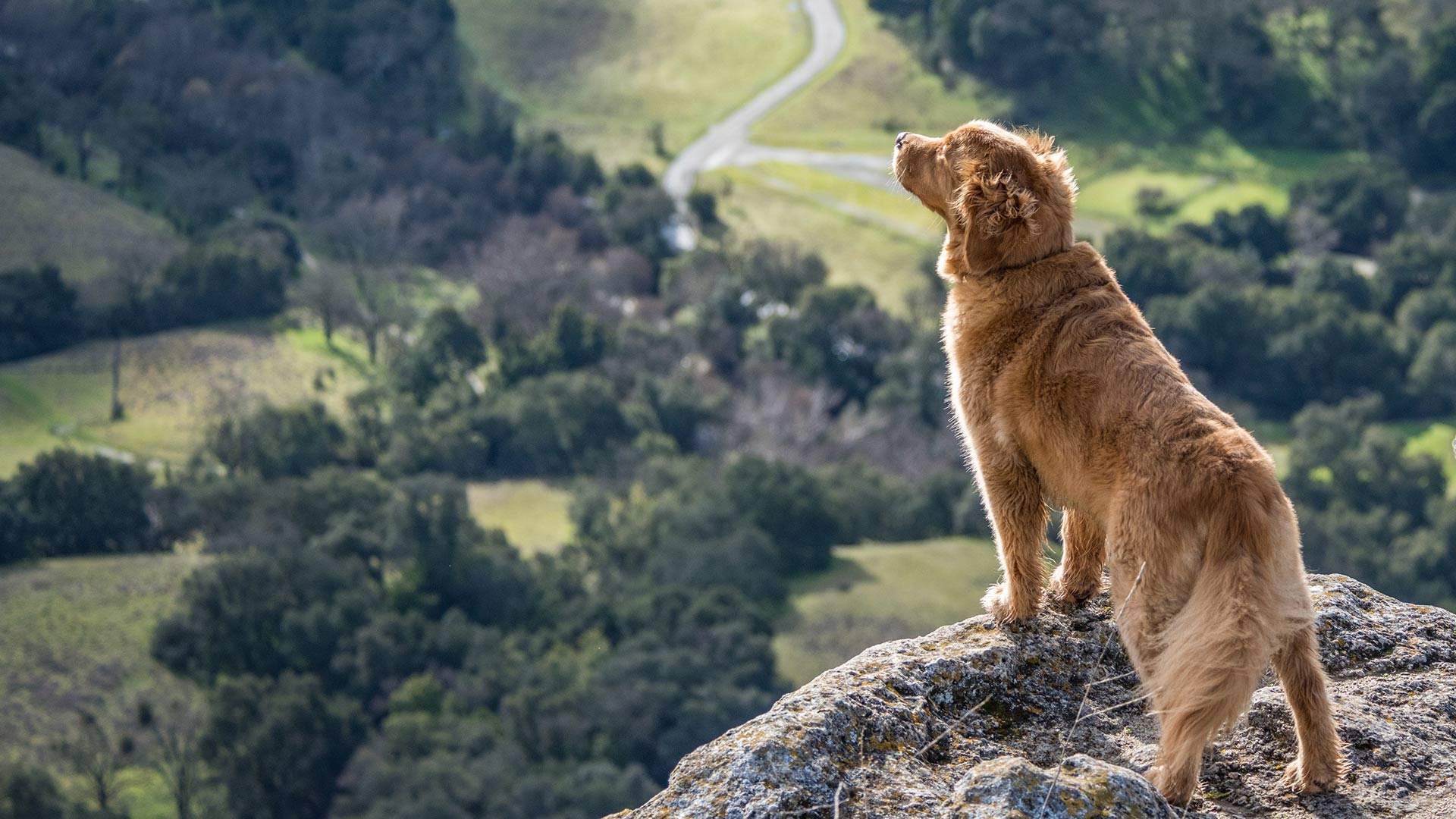
As your parents undoubtedly used to tell you, all you really need is the great outdoors and your own two legs to amuse yourself. And being able to bring your dog along doesn't hurt either. Now that the weather is warming up, it's time for you and your pooch to get back to the outside world.
To help you get started, we've compiled this list of camping, hiking and swimming spots in Victoria to journey to with your pup. We bet your doggo has been missing being in nature even more than you have. So plan your holiday, hop in the car and tell your doggo it's W-A-L-K time.

Recommended reads: The Best Dog-Friendly Accommodation in Victoria The Best Dog-Friendly Bars, Cafes and Restaurants in Melbourne The Best Dog-Friendly Parks and Beaches in Melbourne The Best Dog-Friendly Hotels in Australia
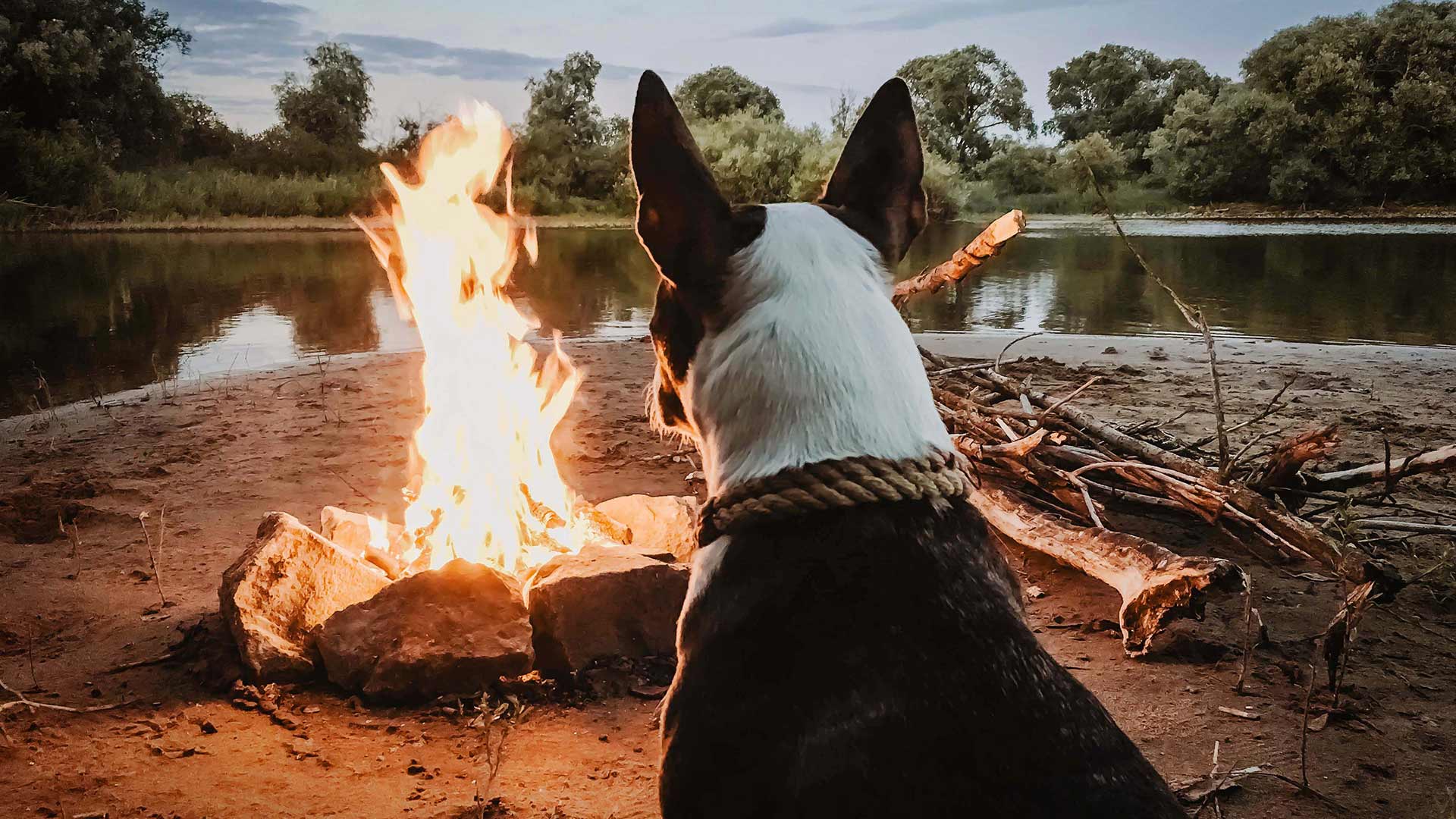
CAMPING: HORSESHOE LAGOON
On the banks of the Goulburn River between Trawool and Kerrisdale, Horseshoe Lagoon is as much of a go-to for water-based activities as it is for settling down for a long weekend of relaxed camping. A flora and fauna reserve, the lagoon is home to many a fine feathered (and furred) friend — so go gently with your doggo.
Get ready to see the full shebang of Australiana fauna including kangaroos, koalas and wombats — and if you're lucky, you may even spot a platypus. Camping is dog-friendly and free along eight kilometres of the bank, with no bookings required.
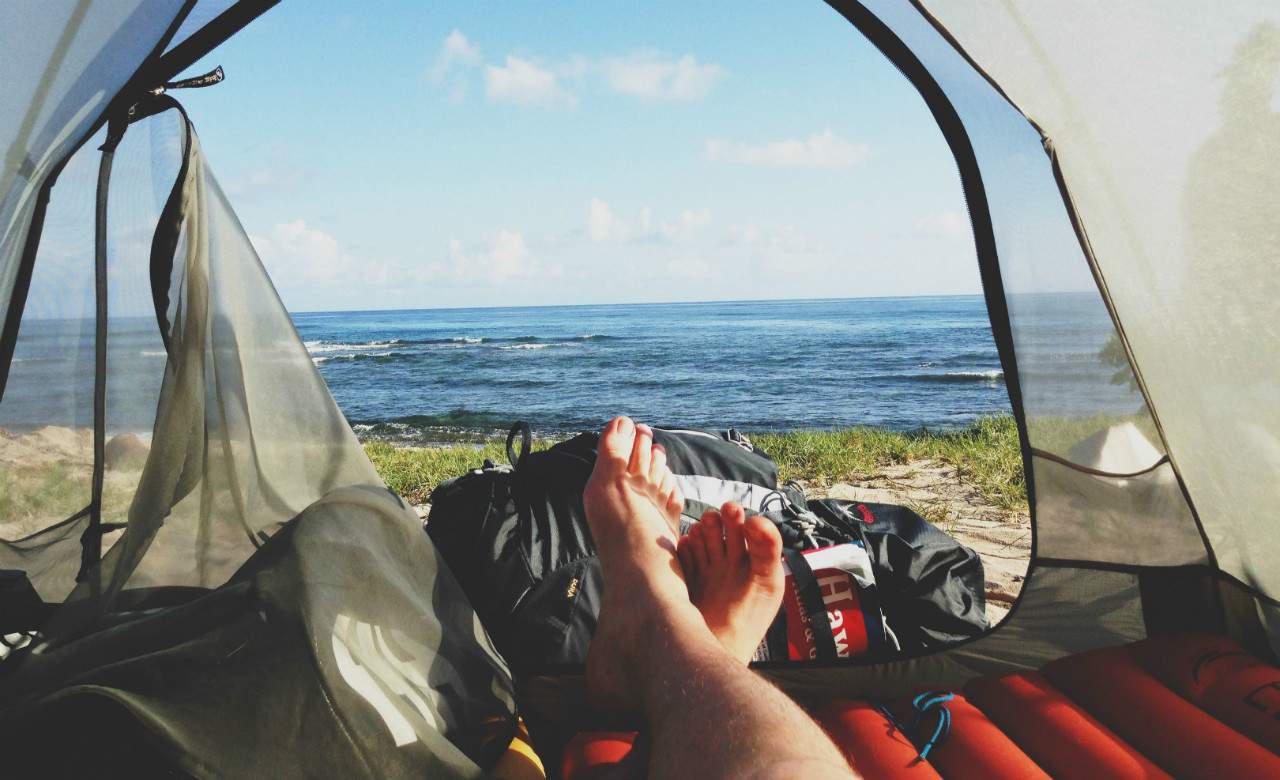
CAMPING: JOHANNA BEACH
Three hours southwest of Melbourne, the campsite at Johanna Beach in the Otways is a triple threat; it has plenty of walks, it's not too busy and it has a beaut surf beach to boot. Off Old Coach Road and set among the dunes, the site only has 25 spots for people to set up camp, so there will never be too many people at one time. But make sure you book in advance book in advance to avoid any disappointment.
There are non-flush toilets in the area, but fires are not allowed and you'll need to BYO drinking water, so this is for human and furry campers who are prepped for a more rugged experience. But the stellar views and the sound of the ocean to wake you in the morning make this trek well worth it.

Takver via Flickr
CAMPING: HEPBURN REGIONAL PARK
Sitting in Victoria's northwest around 1.5 hours from Melbourne, Hepburn Regional Park is a top-notch camping option near the city. Surrounded by picturesque place names like Porcupine Ridge, Wombat Hill and Musk Vale, the Daylesford region already beckons to you on the page. Plus there's the additional draw-card of the spectacular scenery, including natural mineral springs, an extinct volcanic crater and relics from the gold rush set among the bush.
During the day, enjoy a walk or two with your pup. In the evening, settle in by the provided fire pits at the Lalgambook (Mount Franklin) Reserve campsite with your doggo by your side.
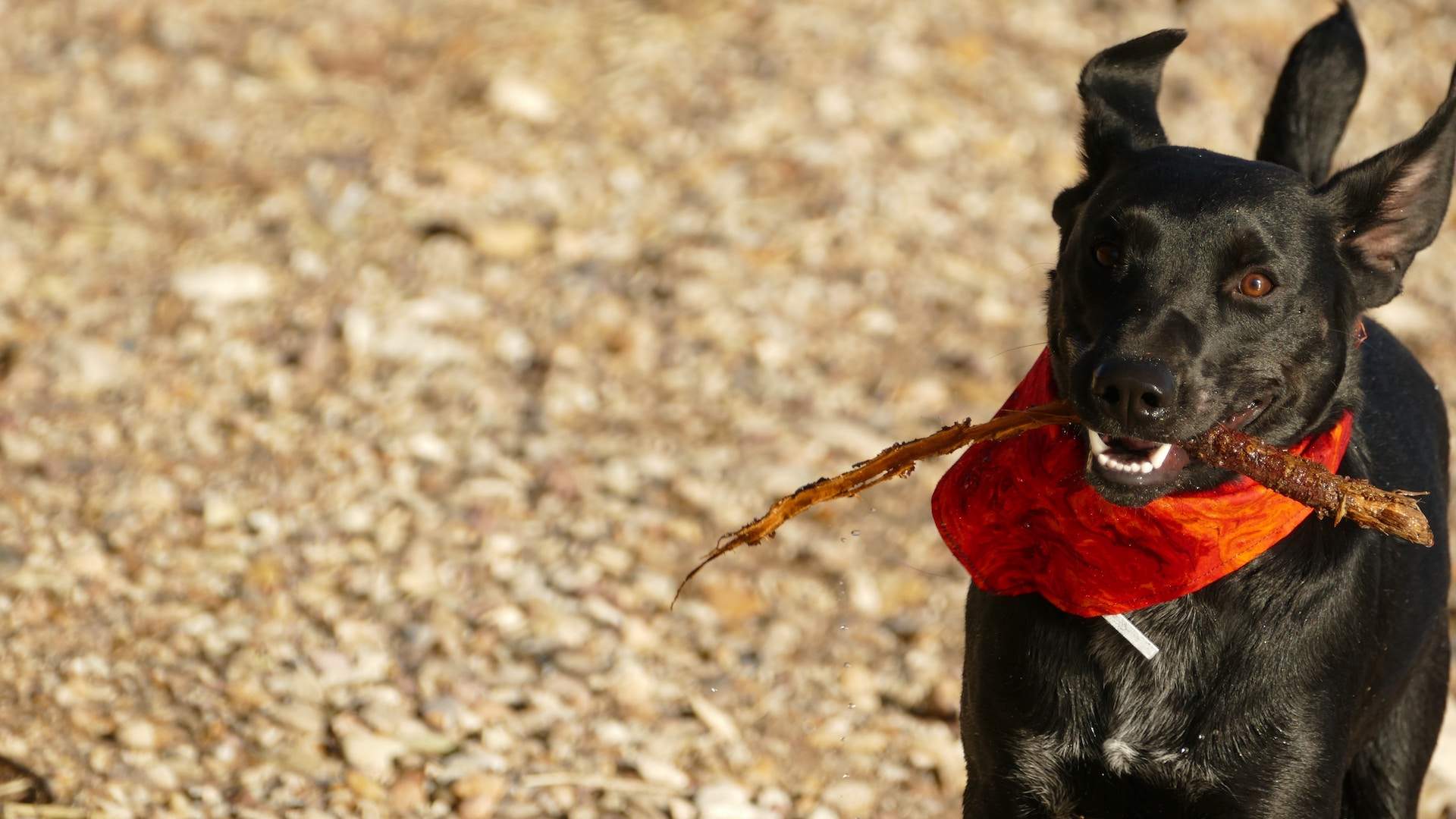
SWIMMING: FOSSIL BEACH
The Mornington Peninsula offers heaps of scenic beaches easily accessible in an hour or so from Melbourne — and Fossil Beach should be at the top of your list. It's lovely, dog-friendly and educational; the rocky beach gets its name from all of the fossils found on its shores. Dating back over ten million years, these Australian sea-life fossils were first discovered in the 1800s, but you can still find plenty to this day. Along with the relics of past aquatic flora and fauna, plenty of present-day wildlife visits the shore, including the yellow wattlebird.
Whether you're a rock lover or nature fan — and perhaps keen for a little dip — stroll along the shore and see what you and your clever pooch might dig up.
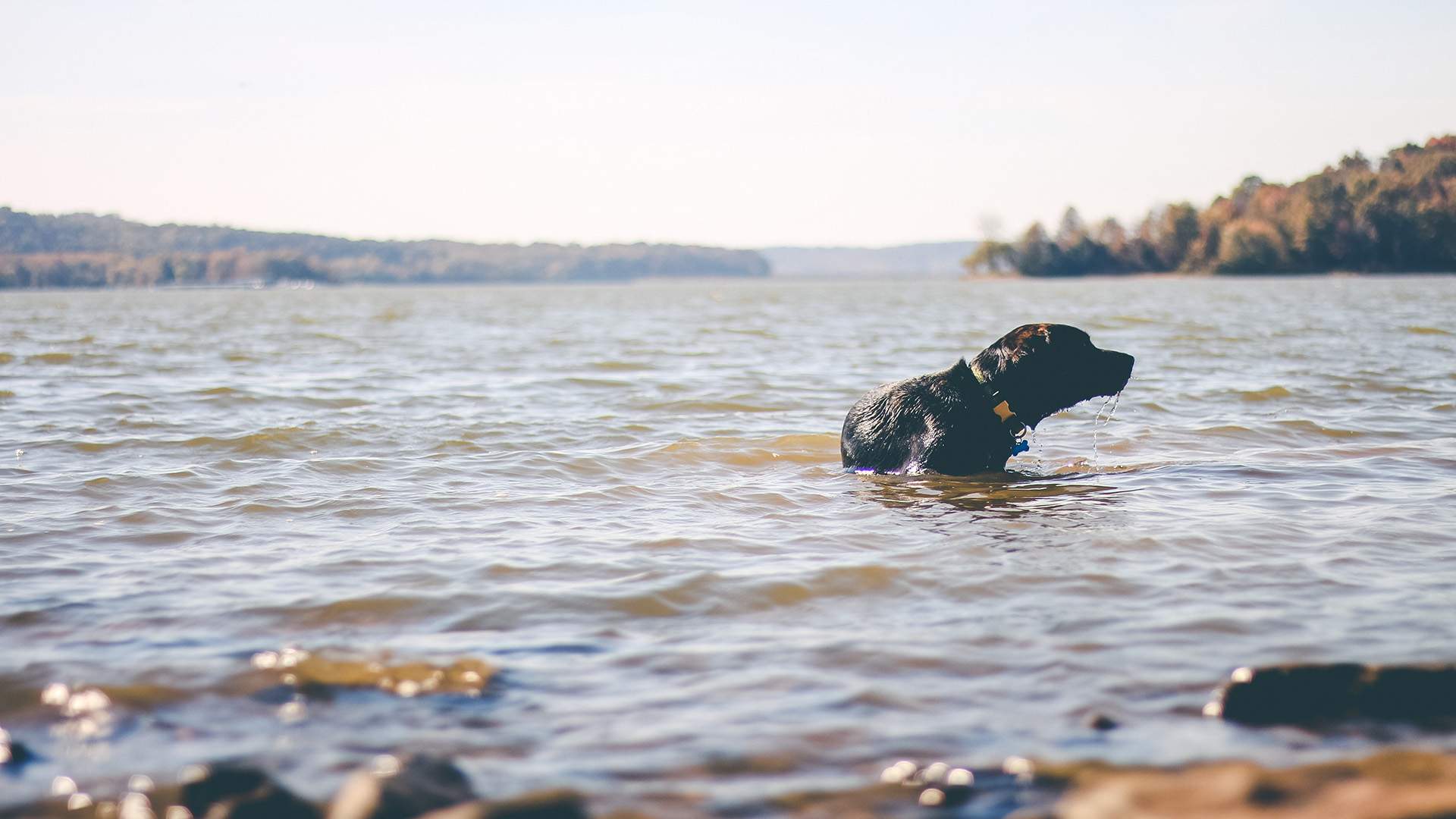
SWIMMING: LILLYDALE LAKE
It isn't just beaches that have the goods when it comes to finding a swimming hole that suits both humans and their fur babies. Don't forget about Victoria's many lakes, and in particular, Lillydale Lake . In the foothills of the Dandenong Ranges, the lake reflects the type of green beauty that can still be found in spades out in Melbourne's hilly east.
The man-made body of water is perfect for walking around — it spans 28 hectares, with an additional ten kilometres of shared trails surrounding the area too. Though the lake may not the best of the best for people swimming, your dog will be raring for a dip along with the other pooches. Afterward, enjoy a picnic in the barbecue area and be sure to bring along snacks for your pup.

Visit Victoria.
SWIMMING: BLUE POOL, BRIAGOLONG STATE FOREST
If you've been hankering for something a little special, it might be time to make the pilgrimage to Briagolong State Forest. Three hours east of the CBD, Blue Pool in Briagolong is worth any distance of travel, and it's a great stop during a coastal road trip or weekend getaway. Here, the water is clear as glass and tends to stay relatively warm all year round. You and your pooch are sure to have a splendid time frolicking and splashing about all day.
Plus, there are several nice walk options around the peaceful billabong surroundings, as well as a campsite nearby, which was recently upgraded, with fire pits, picnic tables and toilets. There's no reason not to make a whole weekend of it. Be sure to come prepared with sandals or water shoes to help you reach the water, as the terrain is very rocky.

HIKING: KURTH KILN REGIONAL PARK
Set in the Dandenong Ranges, Kurth Kiln Regional Park in Gembrook is mostly known for its kiln, used in WWII to make charcoal. It's also home to a water wheel, lots of ferns and the occasional koala. Popular with a whole range of active sorts — hikers, horse riders and mountain bikers — it's a particularly good day trip spot for you and your dog to take.
The lush park has a number of walks, varying in length and difficulty, as well as some more Aussie animals such as sugar gliders, wombats, swamp wallabies and the aforementioned koala if you're lucky. There'll be lots of fun new smells for your dog to discover, so just make sure they're on a lead.

HIKING: YOU YANGS REGIONAL PARK
The peaks of the You Yangs mountain range can be seen from quite a distance, protruding from the otherwise flat landscape surrounding them. So, set your sights on the mountains and head southeast. The regional park that makes up part of the area is ideal for hikes and shorter walks, as well as rock climbing for the especially adventurous. Plus there are barbecues and picnic areas dotted throughout to keep you refreshed and truckin' along.
For those looking to get their legs burning, climb up to Flinders Peak and have a baby Simba moment with your pooch as you survey everything the light touches. Or for something less intensive, take the longer, undulating Branding Yard Walk . Just make sure you bring enough water for both you and your furry pal.

HIKING: MACEDON REGIONAL PARK
The Macedon Ranges are a hallmark of Victoria's native forestry, and the region's fame is in part due to the mysterious Hanging Rock — plus the immense natural beauty (and many wineries) found nearby. The Macedon Regional Park boasts a hefty 2380 hectares and is chockablock with hiking trails that make up the 30-kilometre Macedon Ranges Walking Trail.
With a variety of activities, the Macedon Ranges prove to be a destination, rather than a one-day pit stop. Two of the best dog-friendly hike options are the Camels Hump to Picnic Ground walk — which includes a walk over Macedon's highest peak — and a 2.5-kilometre trot around Sanatorium Lake .
Olivia Rodrigo Is Bringing Her 'GUTS' World Tour to Australia for Her First-Ever Down Under Shows
'the bear' is back: carmy returns to the kitchen in the first trailer for the culinary hit's third season, lego's new 'mona lisa' kit will let you display leonardo da vinci's masterpiece on your own wall, the abc's new season of 'spicks and specks' will get you putting hands on buzzers from june, 'the hunt for gollum' is the next 'lord of the rings' movie — and it's set to hit cinemas in 2026.
- The 21 Best Restaurants in Melbourne
- The 18 Best Bottomless Brunches in Melbourne
- This Is My Manly: Concrete Playground's Local Editor Shares Their Favourite Neighbourhood Gems
- Eurovision Alert: Here's When and Where 2024's Song Contest Is Unleashing Its Europop Marvels
- Where to Find the Best Burgers in Melbourne
- The Ten Best Coffee Shops in Melbourne's CBD
NO ADDRESS FOUND
- Restaurants
- Film & TV
- Sustainability
- Things to Do
List your property with Holidaying with Dogs
Free to list and only 10% commission per booking, free listing in the holidaying with dogs guide book (upgrade options available)..
Join Australia's most trusted pet friendly accommodation site and access our many loyal guests.
Share your love of holidaying with dogs with others and receive property bookings at the same time.
How it works?
- 1 List Your Property
- 2 Manage Reservations
- 3 Receive Payments
- 4 User Reviews
- 5 Reporting (Coming Soon)
By clicking ‘CREATE ACCOUNT’ you are agreeing to the Holidaying with Dogs Terms and Conditions and Privacy Policy
Thank you for joining Holidaying with Dogs
Share your love of holidaying with dogs with others and make money at the same time.
Forget Password

- Personal Information
- Notification Settings
- Payout Settings
- Billing Address
- View booking form
- About this property
- Five paw Awards
- Browse Regions
- Map of Australia

- List a Property
Australia's #1 Pet Friendly Accommodation Site
Trusted by pet lovers for over 30 years
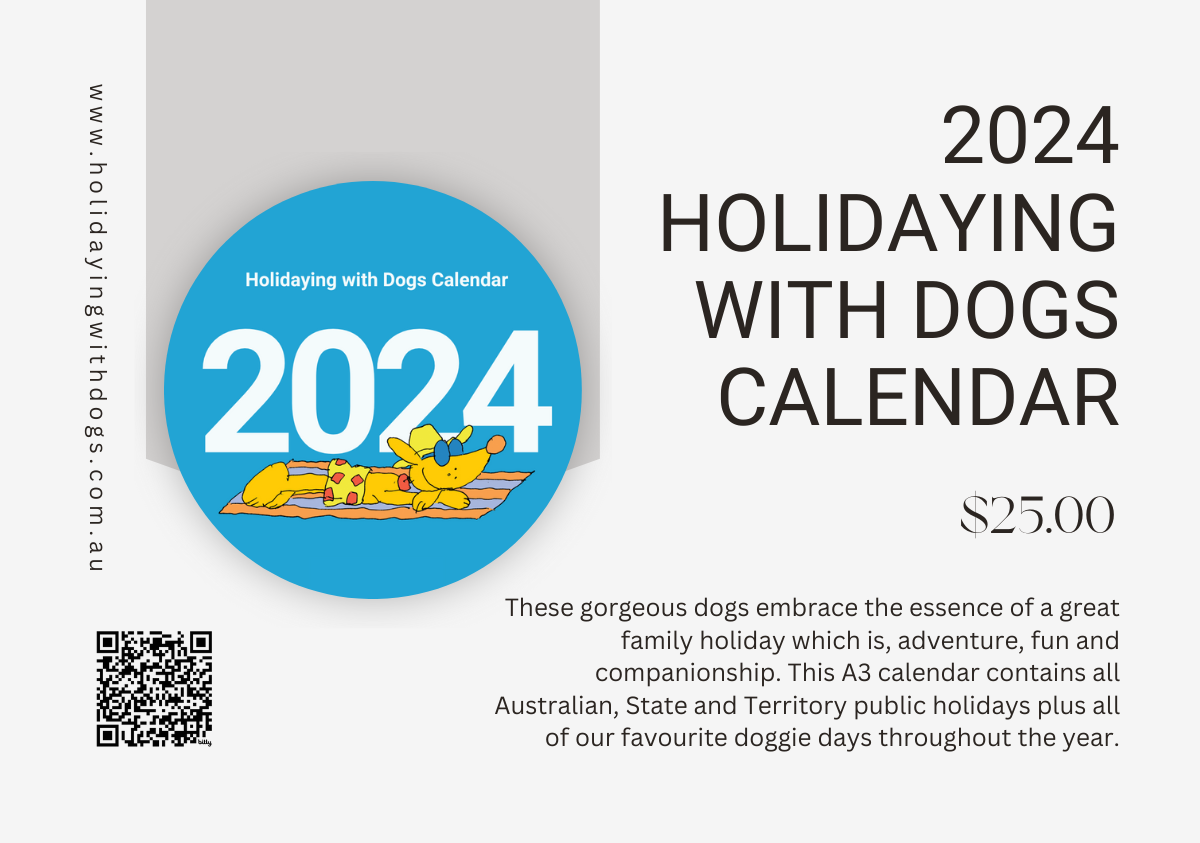
Featured Properties
Dundee Beach Sholly Shack

Bespoke Holiday House

Surfers Beach Cottage Pet Friendly

Echoes at Fingal Bay - Villa 2 - Dogs Welcome!

Lyttle Cook BnB
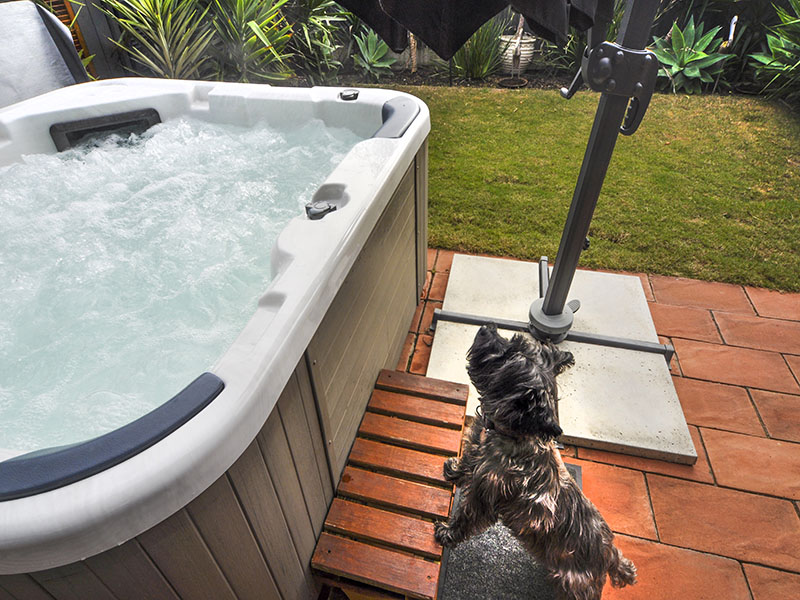
Seagrass Villa 2 at Normanville

Sisters Beach Retreat

Grangeview Cottage
Traveling BC
Discover the beauty of BC
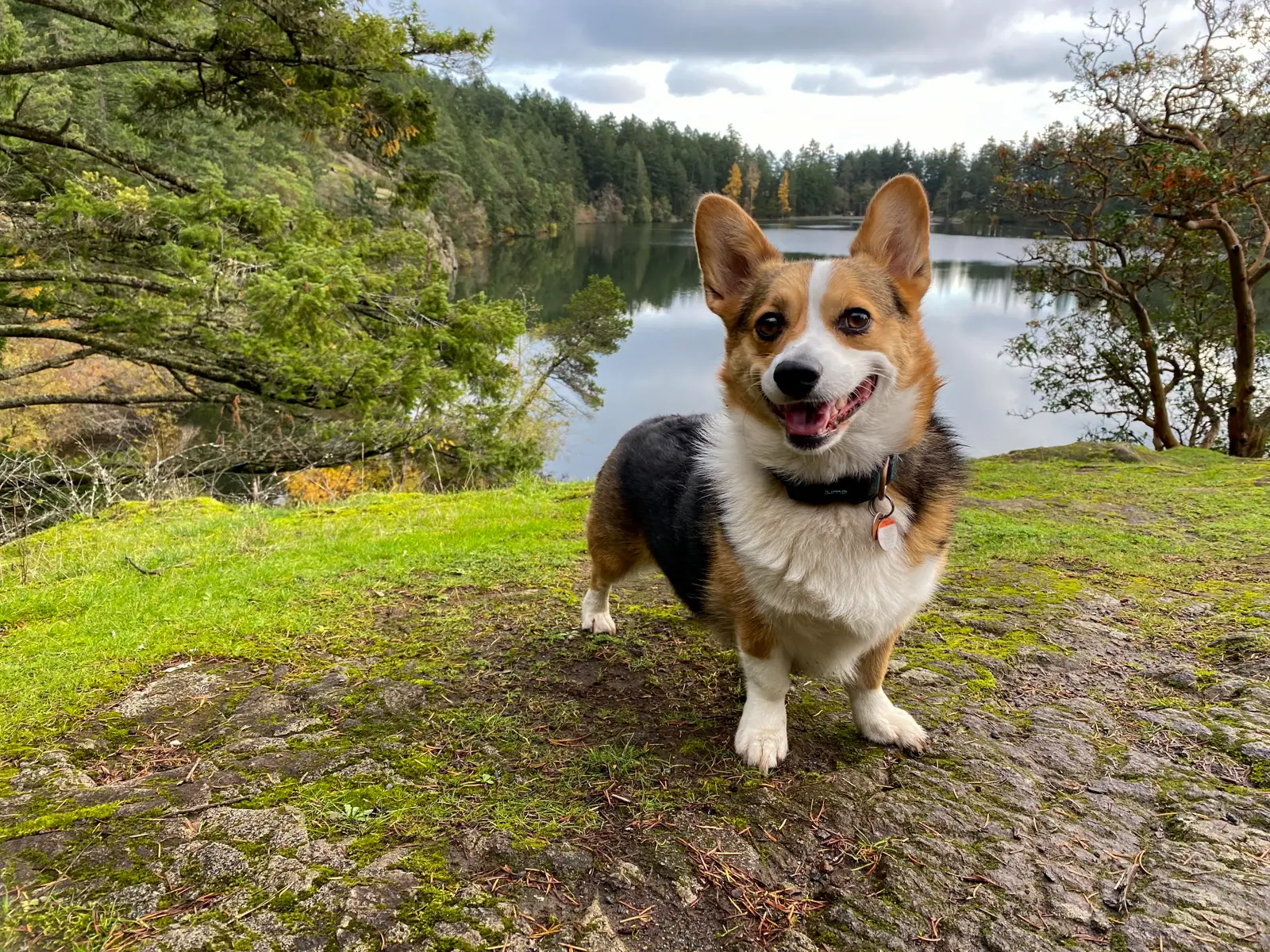
Disclaimer – This post may contain ads and affiliate links that help keep Travelling BC running. If you purchase through these links, we may receive a commission, at no cost to you. Thank you for your support! Learn more.
10 Dog-Friendly Hiking Trails around Victoria, BC
Love heading out for a hike with your dog? You don’t want to leave your pup at home when you head out for some outdoors time. Luckily, with plenty of dog-friendly hiking trails, Victoria, BC is one of the best places to hit the trails with your four-legged friend.
Whether you’re a hiking pro or a beginner, Greater Victoria has plenty of great pet-friendly hikes that you can enjoy with your furry friend. There are hundreds of excellent hiking trails around the city, just waiting to be explored. You don’t even have to go that far out of town!
From paths through towering rainforests to difficult mountain summit hikes, there’s really something for everyone. And the best part? Most of the hiking trails in Victoria are dog-friendly so you have lots to choose from. You’ll never get bored!
If you’re not sure which hiking trail to start with, we’ve compiled some of the best dog-friendly options around Victoria. We’ve hiked through all of these parks and think they’re some of the best hiking spots in the city.
So grab the leash, get out there and explore!
Best Dog-Friendly Hiking Trails in Victoria
Here are some of the best places to hike with your dog around Greater Victoria. Get out there and explore these awesome trails with your furry friend!
1. Thetis Lake Regional Park
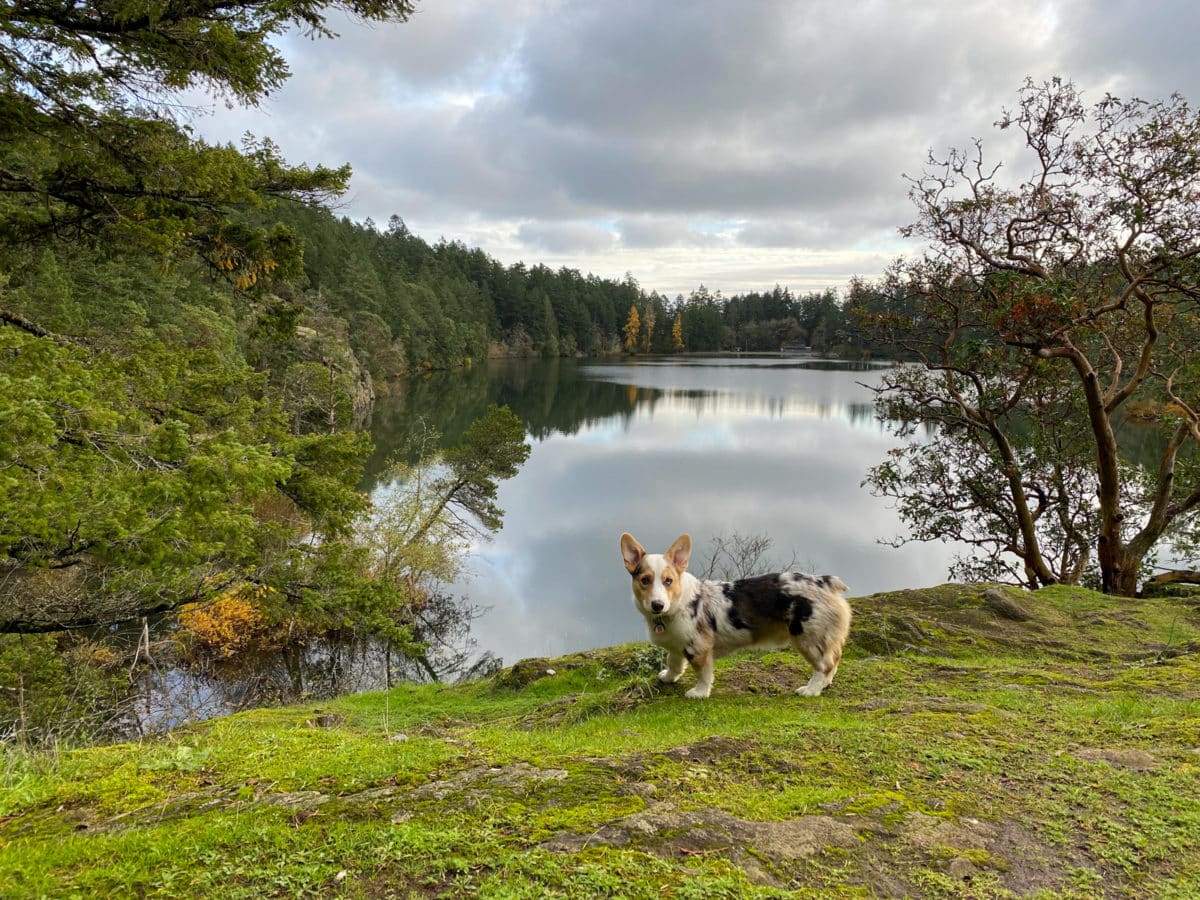
Thetis Lake Regional Park is a favorite dog walking spot for many people and for good reason! There’s an extensive network of trails, the main path around Lower and Upper Thetis Lakes is beautiful and there’s also a dog-friendly beach where your pup can play and cool off.
With over 40 km of trails, Thetis Lake is one of the top places to visit in Victoria for any dog owner who wants lots of choices in hiking trails. Our favorite trail is the walk around Lower and Upper Thetis Lakes — it’s the perfect trail for dogs who love to swim and features some great viewpoints of the water.
Some other great options in the park are the climbs up Seymour Hill, Scafe Hill, or Mount Stewart. All of these trails will give you awesome views of the park!
Thetis Lake is generally off-leash year-round. However, there are seasonal restrictions for beach access with dogs. No dogs are allowed at the main beach at Thetis Lake or the Prior Lake beach and dock area during summer (June 1 – September 15).
Note: If you head to Thetis Lake with your dog, watch out for warnings of blue-green algae in the lakes. These algae blooms are toxic for dogs and occur every summer!
2. PKOLS (Mount Douglas Park)
Arguably, one of the best dog-friendly hiking areas in Greater Victoria is found at the spectacular PKOLS (pronounced p’kawls; also called Mount Douglas Park). Full of towering trees, lush ferns, awesome views, and numerous walking trails, you can wander around this park for hours with your pup!
Mount Doug (as the locals often call it) is a great place to start if you’re new to hiking with your dog. Unless you’re heading straight up the mountain, it’s not too strenuous and there are plenty of places to take a break along the way. The mountain is also right in the city, making it easy to access and less remote than some of the other wilderness parks.
If you want a straightforward walk, head up the paved Churchill Drive to the summit (you can also drive up). Or, give one of the off-road trails a try. We really like the hike to the summit on Irvine or around the mountain on Whittaker.
The views from the top of PKOLS are pretty amazing. Head to the summit and look for landmarks like downtown Victoria, Mount Tolmie, and Mount Baker. The panoramic vistas are breathtaking and worth the climb to get to the top.
Dogs are allowed off-leash at Mount Doug, but there are some seasonal restrictions on where they can go. From May 1 to August 31, dogs are not allowed in the beach areas by Cordova Bay Road.
3. Sooke Potholes Provincial Park
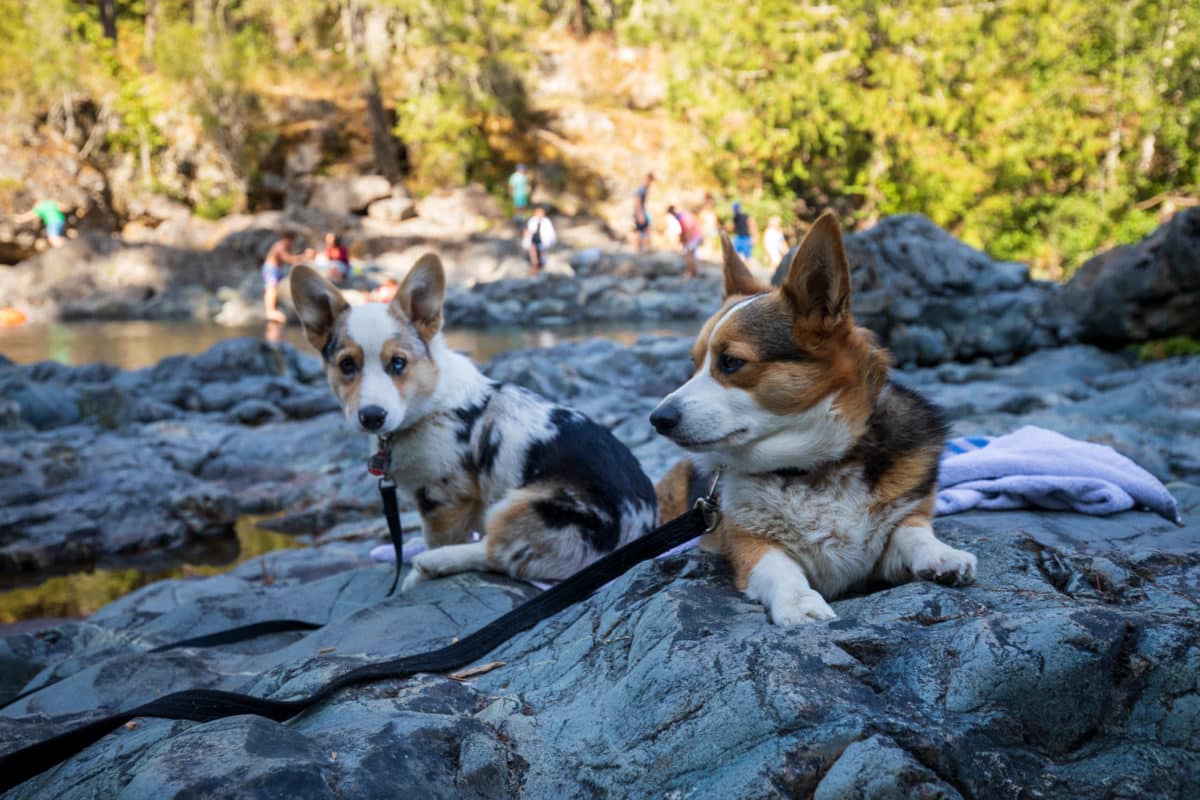
On a hot day, one of the best places to head in Victoria for some hiking and swimming with your dog is the Sooke Potholes Regional Park . There are plenty of swimming spots to take a dip in and your dog will love cooling off in the refreshing water. Just make sure to keep your dog leashed in this park.
The hiking trail at the Sooke Potholes leads you beside the Sooke River, with various beaches and swimming spots along the way. Hike between the beautiful beaches, like Ripple Rock and Sand Pebble Beaches, or spend the day relaxing by the water at one of the potholes.
Don’t want to go too far? Stop at Crescent Beach and enjoy swimming in the large pool of cool river water. There’s also cliff jumping but watch out for rocks!
The Sooke Potholes are also right beside the Sea to Sea Regional Park. Head for a hike to Peden Lake or Mary Vine Creek Waterfall, then wash away your sweat with a dip at the potholes!
4. Sea to Sea Regional Park
With 57 kilometers of trails, the Sea to Sea Regional Park is one of the biggest regional parks around Greater Victoria and one of the best spots for backcountry hiking with your dog. The trails here are moderate to challenging in difficulty, so make sure to wear good hiking shoes!
There are two sections to explore in the Sea to Sea Regional Park: Mount Manuel Quimper and the Lakes Section . All of the trails are excellent, featuring epic mountain viewpoints, mossy trees, beautiful waterfalls, and serene lakes. Your dog will need to stay on a leash throughout the park.
The hike to the summit of Mount Manuel Quimper is a 5.6 km trail one-way, starting from the end of Harbourview Road. At the top, you’ll be rewarded with awesome views of the Sooke Basin and the areas surrounding Sooke. For a shorter round-trip hike of 6 km, head up to the Mount Brulé summit, which still offers some incredible views but won’t take you as long.
The northern section of the Sea to Sea Regional Park offers a variety of beautiful lakes to choose from, including Peden, Crabapple, Shields, and Grass Lakes. Here, you can also hike up to the summit of Empress Mountain or find the beautiful Mary Vine Creek waterfall.
5. Gowlland Tod Provincial Park

Gowlland Tod Provincial Park is a beautiful protected area on the Saanich Peninsula, right beside Finlayson Arm. This stunning wilderness park is perfect for dog owners looking for a strenuous workout for themselves and their pups. There are over 25 km of dog-friendly hiking trails here, each offering unique experiences.
For incredible views of the Finlayson Arm fjord and Saanich Peninsula, we highly recommend either the Timberman Trail to the Squally Reach Viewpoint (6 km) or the Jocelyn Hill Trail Loop (9 km). Both are excellent dog-friendly hiking trails with amazing views of Greater Victoria at the top!
For a shorter dog walk, the hiking trails down to Tod Inlet or McKenzie Bight are both great options. Tod Inlet is accessed from Wallace Drive by Brentwood Bay, making it a great place to stop after exploring the dog-friendly Butchart Gardens . McKenzie Bight gets you up close to the waters of Finlayson Arm and is accessed from Ross Durrance Road.
Because Gowlland Tod is a provincial park, dogs are required to be on a leash at all times. Also, keep in mind that this is a backcountry area and you might run into wildlife like bears or cougars (this is the case for most parks around Victoria)!
6. East Sooke Regional Park
For a day of exploring the coast, head to East Sooke Regional Park with your dog. Here you’ll find 50 km of excellent dog-friendly hiking trails near Sooke that will take you along the rugged coastline, through vibrant rain forests, and up to beautiful inland hilltops.
One of the highlights of this gorgeous West Coast park is the incredible Coastal Trail. This 10.5-kilometer long hiking trail takes you along the rocky coastline of East Sooke, with amazing views of the Juan de Fuca Strait along the way. Start at Aylard Farm or Pike Road, and hike as far as you’d like. For those attempting the entire trail, make sure to park a second vehicle at the other end or you’ll be in for a long trek!
If you prefer forest walks, East Sooke Regional Park also offers several inland trails through the towering coastal forest. We enjoy the Mount Maguire Trail, as well as heading to Babbington Hill. Your dog will love hiking through the forest and smelling all the earthy smells!
7. Goldstream Provincial Park

For a park with lots of things to see, check out Goldstream Provincial Park near Langford. Only about 20 minutes from downtown Victoria, this beautiful riverside park features a salmon spawning stream, gorgeous waterfalls, and excellent dog-friendly walking trails through the West Coast rainforests of Vancouver Island.
With numerous hiking trails, Goldstream is a great place to explore with your four-legged friend. Check out some of the local waterfalls, including Niagara, Hidden Spring, and Goldstream Falls. Walk along the Gold Mine Trail to pass by an abandoned gold mine.
Or, if you want a more strenuous hike, try heading up Mount Finlayson for epic views of the area. Just watch out, some of the sections are quite steep for a dog!
This park is beautiful all year round and is especially nice in the fall when the leaves are changing colors and the salmon are running. However, you’ll need to keep your dog out of the river and on a leash at all times to protect the sensitive ecosystem. Also, the park gets quite busy during this season.
8. Mount Wells Regional Park
For a tougher dog-friendly hike, head to Mount Wells Regional Park by Langford. This 121-hectare protected area offers a challenging 1.3-km one-way trail to the summit of Mount Wells (352 meters).
At the top of Mount Wells, you’ll be treated to spectacular vistas, from the Sooke Hills to the Juan de Fuca Strait. You and your dog will have to work hard to get to the summit, but it’s well worth the effort!
Keep your dog on a leash on this trail — some parts of the hike are quite steep or have nearby dropoffs. You don’t want your pup getting into an accident!
9. Mount Work Regional Park
Mount Work Regional Park is an excellent spot for dog owners to head for a long hike. This massive 743-hectare regional park features 11 km of hiking trails that wind through the forest, around freshwater lakes, and up to the top of the mountain.
The hike up to the summit of Mount Work (449 meters) is a great workout. The trail is about 4 to 5 km long, depending on where you start (either Ross Durrance Road in the north or Munn Road in the south).
The park also has a few beautiful lakes — Killarney, Durrance, and Pease — where your dog can swim and chase sticks. Just make sure to stay off the beaches with your dog during the summertime!
10. Francis/King Regional Park
Francis/King Regional Park is a great place to head if you’re looking for a more relaxed hike. Even so, this 107-hectare regional park is full of natural beauty, from colorful wildflower meadows to ancient Douglas-fir trees.
You’ll find 11 km of dog-friendly walking trails at Francis King Regional Park. The trail difficulties range from accessible to moderately challenging. The Elsie King Trail is a great spot for those with limited mobility to take their dog for some time in nature.
If you want something longer, try the Centennial Trail which loops its way around most of the park. And, for those who really want to stretch their legs, try combining the Panhandle and Highland Trails into a long loop around the entire park.
Tips for Hiking with Dogs in Victoria
- Most regional parks and trails are dog-friendly, but some are on-leash only or have seasonal restrictions. Check on the CRD website to check the rules for each park. All provincial parks are on-leash only.
- Make sure to bring lots of dog poop bags , as you should pack out any excrement and garbage!
- There are some hazards you should watch out for in parks around Victoria. Here are some things to keep an eye out for: poisonous mushrooms, blue-green algae (cyanobacteria) in waterbodies, cliffs, unstable or slippery terrain, and wildlife.
- Wildlife is commonly spotted around Victoria, including raccoons, owls, river otters, deer, black bears, and even cougars. In the more remote parks, carrying bear spray to deter large predators is important. You should also keep your dog in sight, under control, and on a leash, in case you encounter a bear or cougar. Don’t allow your dogs to chase or harass any wildlife.
Top Travel Tips & Resources for Victoria, BC
- Travel Insurance – If you’re travelling internationally, travel insurance is a must for any trip. Being covered by insurance is especially important when you’re going to an adventure-filled place like British Columbia. If you injure yourself while adventuring, you want to have insurance! We recommend using SafetyWing for international travel insurance. They are affordable and have great policies for travellers, digital nomads, and remote workers. Also, SafetyWing provides COVID-19 coverage, which many other insurance companies don’t cover.
- Car Rental – We find the best deal on vehicle rental prices using RentalCars.com . They compare the prices for different car rental companies so you can find the best deals out there!
- Accommodations – We prefer booking all of our hotels, hostels, and other accommodations through Booking.com because they have a flexible cancellation policy. Also, there are lots of different options on their platform, from hotels to vacation homes. Alternatively, Expedia and Hotels.com are good for booking accommodations. For vacation home rentals, VRBO is an excellent choice (they have lower fees than Airbnb, many of the same properties, and are more ethical).
- Flights – You’ll find many good flight deals on Skyscanner or Google Flights. You can book flights through these websites and they’ll help you find the best prices and flight times. If you fly at less popular times (e.g. mid-week or red-eye flights), you can also save some money.
- Tours – Get the most out of your vacation by taking a guided tour! This is a great way to see the city, adventure to exciting new locations, and learn about the local culture. Viator or GetYourGuide are great options for booking tours.
Related posts:
- 36 Best Things to Do in Victoria, BC
- Pacific Marine Circle Route: Road Trip Guide
- Juan de Fuca Trail Backpacking Guide
- 9 Wheelchair Accessible Beaches around Victoria, BC
- 11 Most Beautiful Beaches in Victoria, BC
- 8 Spectacular Viewpoints in Victoria

Hey, I'm Nicole! I've travelled all over the world but my favorite place is British Columbia. I've lived in Victoria, BC since 2019 and spend most of my free time travelling around BC. My goal is to explore as much of this beautiful province as possible. Along the way I'll be sharing travel tips with you!
15 Top Whistler Summer Activities for Adrenaline Junkies
11 best family-friendly hotels in whistler.


Ferry From Port Angeles to Victoria with My Dog
Disclosure: This article contains affiliate links and is a member of Amazon Services LLC Associates Program, meaning when you make a purchase, I earn a small commission. Affiliate links cost you nothing to use, and help keep my content free. It’s a win-win for us both! For more info, see the Privacy Policy
I can totally guess your favorite dog breeds based on how you travel
Take this quiz to see which breeds match your style!
Can dogs go on the ferry from Port Angeles to Victoria?
I took the ferry from Port Angeles to Victoria with my dogs. I needed to get from Washington State to Victoria on Vancouver Island. The best and easiest way to get to Victoria, so my fingers were crossed that pets would be allowed to join in the crossing.
I found not only are pets allowed, but the Black Ball Coho ferry is also actually quite dog friendly. During our crossing, I counted over 10 furry traveling companions. Many were on a leash. Others were in carriers. Some remained comfortably settled in their cars.
To get all the details for a successful journey going on a ferry with my two terriers Sam and Denver including our experience with Canadian immigration , keep reading so you can be prepared for your own crossing.
Pets on Black Ball Ferry, Port Angeles to Victoria

Since dogs and cats can travel for free on the ferry, it is a great and easy way to get back and forth between Vancouver Island and Washington State. Whether you are going on vacation, relocating, or just want to pop over for a day trip, you don’t have to worry about leaving your dog behind.
Since both Washington State and Victoria are dog friendly, your furry companion will have a great time especially if you prepare ahead of time.

Do I need to buy my dog and/or cat a ticket to ride the Coho Ferry in Port Angeles?
Nope. Dogs ride the ferry for free.
However, you will need to pay for your own ticket. If you are bringing a vehicle, there is an additional cost.
I recommend you make a reservation ahead of time especially if you are driving during high season. There are a limited number of cars allowed on the ferry, so you don’t want to miss out by just showing up. When you have a pet with you, it is more difficult to pivot at the last minute if things don’t work out.
Port Angeles Ferry Terminal
The terminal at 430 Belleville Street in Port Angeles is easy to find and navigate in your own car. They have systems in place to direct you where to go and what to do.
What Happens When We Arrive?
Don’t forget your passport. That’s the first thing the employees check before you can enter the area. I thought they might want to check we had our rabies vaccine proof as well, but they didn’t ask for anything related to our terriers.
The ferry recommended taking your dog for a walk prior to getting on the ferry, so I was worried we would miss our chance once we drove into the lot. That concern was completely unnecessary as long as you arrive early like the Blackball Ferry company recommends.
Checking-in for the ferry
We pulled up to the window. The employee looked up our reservation in the system. We handed over our credit card to finalize the payment, and she directed us to a specific line where we should park our car while waiting to board. We had to fill out a little yellow card. It was focused on the humans not the canines.

Waiting to board the ferry
This was the perfect time to take our dogs for a last walk before boarding.
We could leave our car while it was sitting in line. We were given the time we needed to be back in the vehicle. Until then, we could get out and walk around, no problem.
The area is basically a giant paved lot, so it didn’t leave a lot of great space to walk the dogs. That was okay, though because you could leave the lot and go back out to the front sidewalk where there were a few trees and grass patches perfect for a last-minute sniff & pee.
Taking my dog on the Coho Ferry to British Colombia (BC)

Boarding the ferry to Victoria with dogs and/or cats
All the cars drove onto the ferry in the lanes and order we were in the parking lot.
Once inside the belly of the boat, all passengers were required to leave their vehicles. You are allowed to leave your pup inside the car for the crossing. Blackball recommends cracking the windows. Since it is inside without the sun beating on the car, it won’t heat up the way it does in a parking lot. The weather in this area is also fairly temperate. I did think the vehicle area was warmer than I would prefer for leaving a pet in the car but not so hot that it seemed like anything bad would happen.
Your furry friend can also join you above on the crossing. You have to decide which you prefer because you can’t return them to the car or retrieve them from the car mid-crossing unless it is an emergency.
Bringing a dog on the ferry

My pups have never ridden on a ferry before, and there are a lot of new experiences.
- The swaying of the boat makes it difficult to walk/maintain balance for humans and larger dogs
- The engine vibrations could really be felt underneath our feet
- Sounds of clanging, engines, ropes, and other people and dogs
- The other dogs on board the same boat are unfamiliar and while you can spread out, you may have to pass within a few feet inside or walking along the side of the deck
Think of places and experiences you can have with your dog before taking this trip to help them feel more comfortable and relaxed. Places like Lowes and Home Depot would have a lot of similar noises and chaos, so that’s a good place to practice. You could also ride elevators and walk on uneven surfaces on a playground.
We brought our carrier for our Norwich. Denver sees that as a safe space, so he was happy to be inside of it instead of walking around on deck with the big dogs.
Dogs can be inside in the seating area or outside on the deck. They are not allowed to sit at the table or go inside the store/cafe.
The views are beautiful, so enjoy the crossing.
Immigration in Victoria, Canada – Can I bring my dog to Canada?

The ferry will announce when it is time to get back in your vehicle. It takes quite a while for all the cars to have their turn to get off the ferry.
Once off the ferry, depending on where you are in line, you will have to wait in a car line for your turn to drive up to the Canadian immigration booth.
At the booth, they asked for our passports , our purpose for visiting, how long we were staying, and if we had weapons or drugs. The immigration officer did not seem to be interested in our 2 dogs at all, even when Denver barked at her.
We brought our proof of rabies vaccine with us, but the immigration officer did not ask to see it nor did anyone else on the journey.
I’ve learned of enough of other people’s experiences to understand this is common practice. However, you do not want to be in a situation where you are the 20% who is asked to see paperwork and you don’t have it!
The first stop in Canada – Bathroom break
After leaving the immigration booth, you pull out into downtown Victoria. There is nowhere to stop right outside the ferry terminal. However, if you keep going for another couple of blocks, there will be some places you can pull over with trees and grassy areas for a quick pitstop if your pups need it.
What can I do with my dog in Victoria?
Victoria, BC is one of the most dog friendly places we’ve ever been. Our dogs loved going on the stunning walks around Vancouver Island . This ultimate guide will tell you everything you need to know about where to visit, eat and sleep.
FAQ: Bringing my pets to Canada on the ferry
Yes, dogs are allowed on the Black Ball Coho Ferry
Yes, cats are welcome on the Black Ball Coho Ferry
No, a customer service agent confirmed they are not able to go on the ferry.
Nothing, pets ride for free
Yes, pets can go in many locations on the ferry including the seats inside and the deck outside as well as the covered solarium
It should be about 90 minutes from entry to exit and just over an hour on the actual crossing
Yes, the government has regulations that need to be followed . The most important document is the proof of rabies vaccine.

Final Thoughts: Bringing a Dog on the Ferry From Port Angeles to Victoria
The Black Ball Coho Ferry between Port Angeles and Victoria in Canada can be a great option for those traveling with pets. The entire process was smooth and simple. Pets are welcome, and we had no problems with our crossing. Click here to see their schedule and fares .
I do recommend spending some time before your trip desensitizing your pet to some of the more intense sensory stimuli. If you do that ahead of time, you should have a pleasant journey.
There are tons of incredible places to walk with your dog in and around Victoria . See how many you can visit during your trip.
—–We love traveling and we love our dogs
It’s not always easy to combine the two especially when that means getting on flights or crossing borders. We brought our first dog from Kenya to California, and a few years later she went with us to Ecuador before returning to California where we settled down for a while. Now we are gearing up for a new adventure as we look to bring Sam and Denver on our next global journey. This site is a gift of love to my dogs and to others who love their pets so much, they can’t imagine leaving them behind
Similar Posts

Dog Friendly Lost River, West Virginia: An Insider’s Guide
Is Lost River, West Virginia a good place to visit with my dog? Lost River, West Virginia, nestled in the Appalachian Mountains, is more than just a hidden gem for…

The 14 Most Dog Friendly Cities in the US
Have you been wondering about the most dog-friendly cities in the US? If you are trying to find the best place to visit with your dog in the US, the…
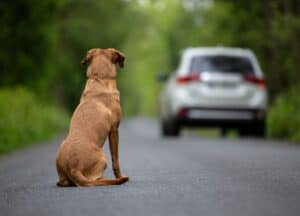
How to Get a Large Dog into a Car: 5 Simple Steps
Traveling with your dog can be an exciting and rewarding experience. However, getting a large or elderly dog into a car can sometimes pose challenges. As a terrier owner, I…
![travel with dog victoria Is Home Depot Dog Friendly? [Official Pet Policy]](https://petsaroundtheworld.org/wp-content/uploads/2023/04/Home-Depot-Sign-edited-300x240.jpg)
Is Home Depot Dog Friendly? [Official Pet Policy]
Are dogs allowed in Home Depot? Thinking about taking your dog with you on your next trip to the hardware store? We totally get it. For those of us who…

Why Is My Dog Panting in the Car? Seven Valuable Tips for a More Comfortable Ride
When you’re in the car with your dog, you probably think a lot about how to keep them safe and comfortable. It is pretty common for a dog to start…

What To Do With Your Dog When You Travel
Trying to figure out what to do with your dog when you travel? No problem. We cover the most common ways to make your trip possible. So whether you decide…
Travelling with dogs
When travelling with dogs it is the owner or person in charge's duty to make sure the animal is transported appropriately and provided with its essential needs, including:
- protection from heat or cold
- a safe position on the vehicle.
Legal obligations when travelling with dogs
The Prevention of Cruelty to Animals (POCTA) Act and Regulations include several mandatory requirements for traveling with dogs in or on a vehicle:
It is illegal to:
- put dogs in the boot of a sedan type car
- leave an animal unattended inside a car for more than 10 minutes when outside temperatures are at or above 28 degrees Celsius
- transport a dog if it is not appropriately tethered or caged on back of ute or trailer
- secure a dog on the metal tray of a ute or trailer when outside temperatures are at or above 28 degrees Celsius without the dog having access to an area of insulating material protecting the dog from contact with the metal surface.
Dogs can travel in the cabin of the car or behind a cargo barrier in the back of wagon or SUV type vehicle.
When travelling, dogs must be provided with effective ventilation to avoid heat or cold stress.
Dogs and heat stress

Dogs in vehicles and on the back of vehicles can suffer from heat stress and exhaustion during the warmer months of the year. Dogs can dehydrate or even die from heat stress. The interior of vehicles can heat up quickly causing heat stress and potential death to dogs.
- Park the vehicle in the shade.
- Leave your dog with water.
Travelling with dogs on the back of vehicles
The law in Victoria requires that dogs on utes are restrained either via a tether or cage, so that the dog cannot fall off or be injured when the vehicle moves. The only exception is for dogs that are actively working livestock.
What are the dangers of travelling with dogs on utes?
Many dogs nation-wide are killed or injured from travelling on the back of open and moving vehicles each year.
Common causes of injury are dogs:
- falling off the back of the vehicle whilst it is moving
- being struck by oncoming or passing vehicles
- being dragged alongside moving vehicles
- attempting to jump from moving vehicles.
How to prevent these dangers
If a lead or chain is used to secure a dog, it must be long enough to allow the dog to sit and lie down and short enough so the dog cannot:
- reach the sides of the vehicle
- get onto the cabin
- harass passers-by when the vehicle is parked.
Long tethers can be more dangerous than not using one. If the dog does fall off the vehicle it can be dragged or strangled.
It is also important to use swivels to attach the tether to both the vehicle and the dog's collar to prevent the chain from tangling. Never use twine, thin rope or similar materials as these can cause injuries if the dog becomes tangled in the tether.
If using a cage, maximise the dog's safety and comfort by ensuring the cage is:
- the right size to prevent cramping and overcrowding
- well covered to provide shelter from sun, wind and rain
- placed directly behind the cabin to minimise exposure to dust and wind
- well ventilated (mesh rather than solid material).
Travelling safely with dogs inside vehicles
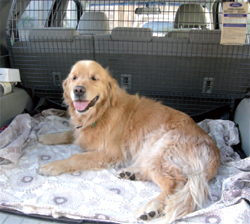
Best practice is for dogs to travel in the cabin of the vehicle and are kept either:
- on the backseat using an appropriate seatbelt or restraining device
- in the open cargo area of a vehicle behind a cargo barrier.
Dogs need to be adequately restrained when travelling inside a vehicle for the safety of both the dog and human passengers. Unrestrained dogs can cause accidents and should never be allowed in the vicinity of the driver. In the case of an accident, an unrestrained dog can become a projectile and damage itself and people in the vehicle.
Dogs should not be allowed to travel with their head out of the car window. Particles of dirt can enter a dog's eyes, ears and nose — causing injury or infection.
If you are going on a long trip carry:
Make sure you stop regularly for your dog to exercise and have a toilet break.
Remember, if you love your dog look after it and restrain it when travelling.
The Victorian Code of Practice for the Private Keeping of Dogs contains more information on travelling safely with dogs.
- Travel and boarding
Confirm New Booking
Another booking already started.
You have another booking already started. Confirm you want to clear it and continue with your new booking.
Travelling with pets
Travel tips for pet owners.
Check out some helpful pet travel tips from BC SPCA Accredited Dog Trainer, Bernadette:
Onboard Pet Areas
To help you and your pet feel comfortable and at home, Pet Areas on board are equipped with:
- Garbage bins
- Heating (available in select Pet Areas)
- Kennels (available in select Pet Areas)
Top travel tips for pet owners
The Canadian Veterinary Medical Association–Society of British Columbia Veterinarians has some great tips to make your pets as comfortable as possible on board:
- Give your pet some exercise before boarding the ferry
- Keep your pet hydrated with enough water, especially on hot days
- Bring your pet’s favourite blanket or toy
- Bring your own padlock if you wish to use our onboard kennels
- Keep dogs on a leash and under your care when outside your vehicle
- Clean up after your pet to help us ensure a clean environment for everyone on board
- Ensure all vaccinations are up to date and your pets are in good health
- Bring cats, ferrets and other small animals on board in a carrying case
- During the colder months, terminals and vessels may employ a de-icing compound outdoors. Owners are responsible for their pet's welfare and should be aware of any associated risks.
- Foot passengers with pets must embark and disembark from the main car deck unless instructed otherwise.
Outer deck pet area expansion on select vessels and routes
You barked and we listened. The below six vessels have expanded their pet areas with a designated upper area on the passenger deck:
- Queen of Oak Bay – Sailings between Horseshoe Bay – Nanaimo
- Queen of Cowichan – Sailings between Horseshoe Bay – Nanaimo
- Queen of Coquitlam – Sailings between Nanaimo- Horseshoe Bay - Langdale
- Queen of Surrey – Sailings between Horseshoe Bay - Langdale
- Salish Orca – Sailings between Powell River – Comox
- Malaspina Sky – Sailings between Earls Cove – Saltery Bay
- Leashes must be kept to a maximum of 3 feet (1 meter) at all times when on board.
- Access the outside pet area via a designated pet friendly stairwell and follow the paw prints. Crew can direct customers with accessibility requirements to a designated elevator.
- Pets must remain within the designated pet area, marked by yellow lines, when on the upper outside deck.
- Pets are not permitted in terminal lounges or on passenger walkways, inside the passenger lounge or Coastal Cafe areas of the ferry.
- Be considerate of fellow passengers who do not want to come in contact with an animal.
Why are we expanding our pet areas?
In response to customer feedback to enhance the travel experience for passengers travelling with pets, BC Ferries is permitting dogs on leash and cats in carriers to access designated areas of the upper outside passenger decks of specific vessels and routes. This will expand the pet areas on board select ferries.
Will we allow pets on outer decks on other ferries?
We plan to expand the program to additional ferries on other routes in phases. It will take time to assess all ferries and prepare designated areas to ensure it is safe for pets and their owners. We will keep customers up to date about this travel enhancement. Note: When travelling on northern routes between Port Hardy–Bella Bella–Bella Coola–Prince Rupert–Skidegate pets must remain in your vehicle or in a kennel available in the designated pet area on the vehicle deck. On these vessels, no customers are permitted on the vehicle deck during the sailing, however, customers will be permitted short, accompanied visits to the vehicle deck to check on their pet every few hours.
What tools or equipment will be available for pet owners to clean up after their animals?
Waste bags and bins will be available in the pet areas. Hoses will be available for crew to use if required. If you have any concerns about the cleanliness of the pet areas, let any crew member know.
What are the rules for aggressive dogs?
Dogs with a bite history or that display aggressive behaviour are prohibited in any of our designated pet areas. At any time, BC Ferries reserves the right to ask that you and your pet leave the premises. All dogs must be on a leash no longer than 3 ft/1 m at all times. In the remote chance a customer is bitten by a dog, we have trained occupational first aid attendants on board.
How can I provide my feedback about the new outer deck pet areas?
Your feedback helps us to continually improve our customer’s experience. Submit your feedback .
- For easy access to the onboard Pet Area, you and your pet will board the ferry via the vehicle deck before vehicles are loaded
- If you arrive after vehicles have started loading, please wait until a crew member signals for you to board on the loading ramp
- For everyone’s safety, including your pet’s, we do not permit walk-on passengers and vehicles to board at the same time
- When it’s time to get off the ferry, you will hear an announcement for passengers to return to their vehicles. Please make your way to the disembarkation area (often on the lower vehicle deck). Once the ferry is secured, a crew member will direct you to walk off the vessel with your pet before vehicles unload.
- Remove your pet’s leash so it doesn’t tangle
- Routinely check on your pets to make sure they are comfortable and calm
- Check that the kennel door is securely closed and locked with your own padlock before you leave
- Return to the Pet Area once you hear the onboard announcement that the ferry is nearing the terminal
- Please clean up any waste from your pet after using the kennels
What you need to know about travelling on our ferries with a vehicle.
See what goods are classified as dangerous, and learn how to declare them before you travel.
Take advantage of our secure check-in baggage services - available for foot passengers on select routes.
- Join Our Newsletter
- Post a Listing
- Your Listings
- Your Profile
- Your Subscriptions
- Payment History
- Sign up for Daily Headlines
- Sign up for Notifications
Here's what to know if you are traveling abroad with your dog
- Share by Email
- Share on Facebook
- Share on LinkedIn
- Share via Text Message
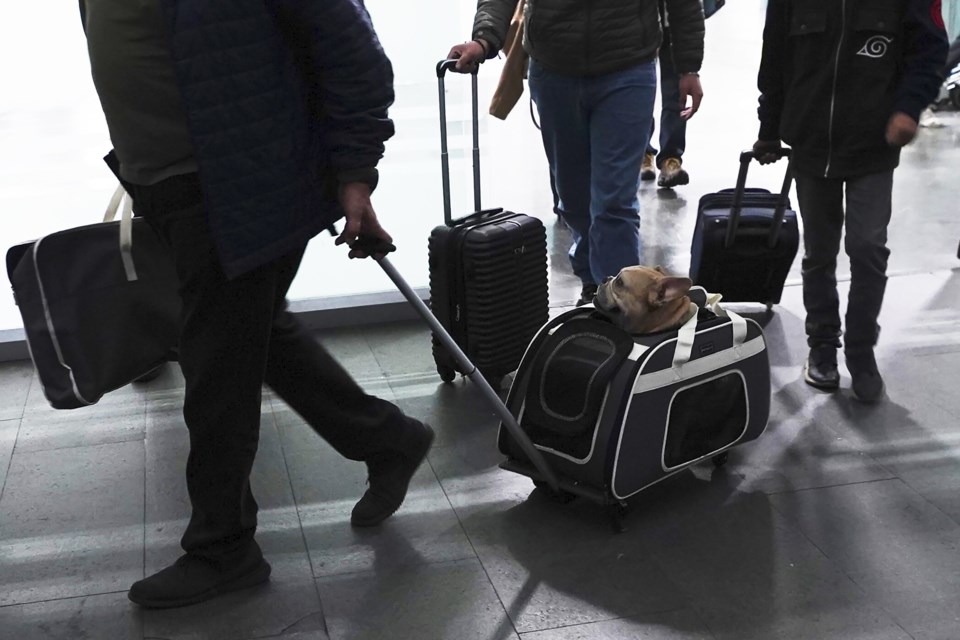
If you are bringing a dog into the U.S. — whether if you are returning from a trip overseas with Rover, visiting the U.S., or adopting a dog from abroad — you have to follow a set of new rules designed to help prevent the spread of rabies.
The Centers for Disease Control and Prevention last updated these rules in 1956, when far fewer dogs came to the U.S. from other countries, officials say. About 1 million dogs now enter the U.S. every year.
There are additional restrictions if the dog has been in many countries where rabies is common. You can find the list of those countries on the CDC website .
The new rules go into affect Aug. 1. There's a checklist on the CDC website .
Here's what to know about about the rules:
— Dogs have to be healthy and at least 6 months old when they arrive in the U.S.
— The dog must have a microchip implanted under their skin, which contains identifier information.
— A CDC import form must be filled out in advance, and include a photo of the dog.
— Proof of rabies vaccination is required only if the dog was in a high-risk country in the past six months.
— For dogs vaccinated in the U.S., a certificate endorsed by the Agriculture Department is required.
— For dogs vaccinated outside the U.S., a certificate of vaccination is required along with a blood test, and the animal has to be examined at a CDC-registered facility on arrival in the U.S.
The Associated Press Health and Science Department receives support from the Howard Hughes Medical Institute’s Science and Educational Media Group. The AP is solely responsible for all content.
The Associated Press
- See a typo/mistake?
- Have a story/tip?
This has been shared 0 times
More the mix.

Featured Flyer
- Skip to main content
- Keyboard shortcuts for audio player
Your Health
- Treatments & Tests
- Health Inc.
- Public Health
The CDC issues new rules for bringing dogs into the U.S., aimed at keeping out rabies

Traveling internationally with a dog — or adopting one from abroad — just got a bit more complicated. The CDC issued new rules intended to reduce the risk of importing rabies. mauinow1/Getty Images/iStockphoto hide caption
Traveling internationally with a dog — or adopting one from abroad — just got a bit more complicated. The CDC issued new rules intended to reduce the risk of importing rabies.
The Centers for Disease Control and Prevention announced new rules Wednesday aimed at preventing dogs with rabies from coming into the United States.
Under the new regulations, all dogs entering the U.S. must appear healthy, must be at least six months old, must have received a microchip, and the owner must verify the animal either has a valid rabies vaccine or has not been in a country where rabies is endemic in the last six months.
Dogs coming from a country that is considered at high risk for rabies and who received a rabies vaccine from another country must meet additional criteria. Those include getting a blood test before they leave the other country to make sure the animal has immunity against rabies, a physical examination upon arrival and getting a U.S. rabies vaccine. If the dog doesn't have a blood test showing immunity, it must be quarantined for 28 days.
These are much stricter requirements than existing regulations for dog importation — for those who want to adopt from abroad and for those traveling internationally with their pets.

Shots - Health News
Vaccine hesitancy affects dog-owners, too, with many questioning the rabies shot.
But, U.S pet owners shouldn't panic, says Dr. Emily Pieracci , a CDC veterinary medicine officer. "This really isn't a big change," she says. "It sounds like a lot, but not when you break it down, it's really not a huge inconvenience for pet owners."
Rabies was eliminated in dogs in the United States in 2007 , but unvaccinated canines can still contract the disease from rabid wildlife such as raccoons, skunks or bats.
And rabies remains one of the deadliest diseases that can be transmitted from animals to humans around the world. Globally, about 59,000 people die from rabies each year. The illness is nearly always fatal once a person begins to experience symptoms .
Today, pet dogs in the United States are routinely vaccinated against rabies.
"This new regulation is really set to address the current challenges we're facing," Pieracci says. Those include an increased risk of disease "because of the large-scale international movement of dogs," she adds, as well as fraudulent documentation for imported dogs.
The U.S. imports an estimated 1 million dogs each year. In 2021, amid a surge of pandemic-inspired dog adoptions, the CDC suspended importations from 113 countries where rabies is still endemic because of an increase in fraudulent rabies vaccination certificates. The countries include Kenya, Uganda, Brazil, Colombia, Russia, Vietnam, North Korea, Nepal, China and Syria.
That suspension will end when the new rules go into effect Aug. 1.
"This will bring us up to speed with the rest of the international community which already has measures in place to prevent the importation of of rapid dogs," Pieracci said. "So, we're playing catch-up in a sense."
The new regulations replace rules that date back to 1956. Those rules only required that dogs be vaccinated before entering the country.

To control rabies in wildlife, the USDA drops vaccine treats from the sky
"As you can imagine a lot has changed since then," Pieracci says. "International travel has increased dramatically and people's relationships with dogs have changed since the 1950s. During that time, it really wasn't common for dogs to be considered family member. They didn't sleep in peoples' beds. They certainly didn't accompany them on international trips."
The new rules won praise from the American Veterinary Medical Association . The organization "is pleased to see the implementation of this new rule that will help protect public health and positively impact canine health and welfare," said Dr. Rena Carlson, president of the AVMA in a statement to NPR.
Dog rescue advocates also welcomed the changes.
"This updated regulation will allow us to continue bringing dogs to the U.S. safely and efficiently," Lori Kalef, director of programs for SPCA International, said in a statement.
"We have seen that dogs have been a lifeline for U.S. service members during their deployments. One of our key programs reunites these service members and their animal companions here in the U.S. once they have returned home," she said. "The CDC's commitment to improving its regulations has a profound impact on the animals and service members we support, and this new policy is an important piece of that effort."
- importing dogs
From August 1, 2024, Onward: What Your Dog Needs to Enter the United States
At a glance.
Starting on August 1, 2024, dogs entering or returning to the United States must meet new, specific requirements depending on where they have been in the 6 months before entering the U.S. and where they received their rabies vaccines (if required).
Requirements for all dogs
Requirements for dogs with a current and valid rabies vaccination administered in the united states.
- Requirements for foreign-vaccinated dogs that have been in a country with high risk of dog rabies within 6 months before entry
Requirements for dogs that have been ONLY in countries that are dog rabies-free or low-risk during the 6 months before entry
All dogs must:
- Be at least 6 months of age at time of entry or return to the United States
- This must have been implanted prior to any required rabies vaccination
- The microchip number must be documented on all required forms and in all accompanying veterinary records
- Dogs may not enter the United States if they are carrying a disease contagious to people.
- Isolation of the dog, veterinary examination, and additional testing, at the importer’s expense, may be required to determine if the dog has a contagious disease and prevent spread if the dog does not appear healthy upon arrival.
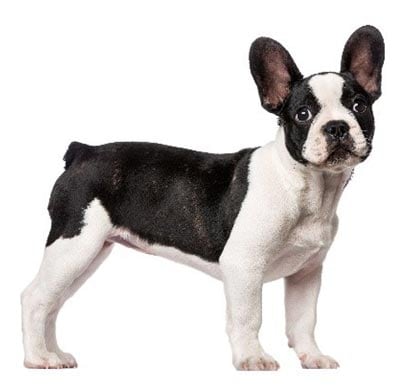
This form should be filled out online 2-10 days before arrival. If the information on the form changes before the dog arrives, you must submit a new form and indicate you are making changes to an existing form. All information, including port of entry where the dog is arriving, must be correct at time of arrival.
- This form requires you to upload a clear photograph of the dog showing its face and body. Dogs that will be less than one year of age at time of arrival should have the photograph taken within 10 days before arrival.
- There is no charge to importers for submitting this form.
- Additional requirements for dogs with a current rabies vaccination administered in the United States
- Additional requirements for dogs that have been in a country at high-risk for dog rabies within the 6 months before entry and do NOT have appropriate documentation of current US-issued rabies vaccine
- Additional requirements for dogs that have been ONLY in countries that are dog rabies-free or low-risk in the 6 months before entry
Dogs that do not meet all entry requirements or do not have accurate and valid forms will be denied entry to the United States and returned to the country of departure at the importer’s expense. These requirements apply to all dogs, including service dogs and dogs that were born in the United States.
Specific requirements depend on whether the dog has been in a high-risk country for dog rabies in the past 6 months.
Dogs with a current rabies vaccination administered in the United States that have been in a high-risk country for dog rabies must:
- Meet all requirements in the “All Dogs” section above
- The Certification of U.S.-issued Rabies Vaccination form is required for the importation (re-entry) of U.S.-vaccinated dogs that have been in high-risk countries for dog rabies within the 6 months before re-entry into the United States.
- Please note, for dogs that left the United States before August 1, 2024, and have been in a high-risk country, the importer may instead present a copy of the USDA Animal and Plant Health Inspection Service (APHIS)-endorsed export health certificate that was used to ship the dog from the United States, if that export health certificate documents the microchip number and valid rabies vaccination administered in the United States. The rabies vaccination must be valid (not expired) on the date of return or the form will be invalid.
- Arrive at the location listed on the CDC Dog Import Form receipt (This can be any airport, land border crossing, or sea port but you must select this location when you complete the CDC Dog Import Form.)
Dogs with a current rabies vaccination administered in the United States that have NOT been in a high-risk country in the last 6 months must:
- A Certification of U.S.-Issued Rabies Vaccine form that was endorsed by USDA before the dog departed the United States; or
- The USDA export certificate must demonstrate the dog is 6 months of age or older and list the microchip number.
- The export certificate must be for the dog rabies-free or low-risk country where the dog’s return itinerary originated.
- Arrive at the location listed on the CDC Dog Import Form receipt (This can be any airport, land border crossing, or sea port but you must select this location when you complete the CDC Dog Import Form .)
Important information about the Certification of U.S.-Issued Rabies Vaccination Form
The Certification of U.S.-Issued Rabies Vaccination form must be completed before the dog departs the U.S. Before asking your veterinarian to complete this form, verify the following requirements will be met:
- Ensure your dog will be at least 6 months of age on date of return to the U.S.
- Have your dog microchipped with an International Organization for Standardization (ISO)-compatible microchip (implanted before any required rabies vaccinations)
- Ensure the veterinarian scans the dog for the ISO-compatible microchip and records the microchip number at the time of vaccine appointment. Rabies vaccines administered prior to microchip implantation will not be considered valid.
- Ensure the rabies vaccination will be valid for the entire duration of your travels. If your dog’s U.S.-issued rabies vaccination lapses while overseas and your dog has been in a high-risk country in the past 6 months, your dog will need to be revaccinated overseas and meet requirements for foreign-vaccinated dogs to return to the U.S., including having a rabies serology titer, arriving at a specific port of entry, and possible quarantine requirements.
- Your dog’s first rabies vaccination must be administered at least 28 days before travel.
- Ensure the veterinarian submits this form to the USDA for official endorsement through the VEHCS portal
- Your dog must travel with a printed copy of the official endorsed form upon your dog’s return to the United States if your dog has been in a high-risk country within the 6 months before returning to the U.S.
Dogs that departed the U.S. prior to August 1, 2024, and have been in a high-risk country in the past 6 months, may have either the Certification of U.S.-Issued Rabies Vaccination form or the USDA APHIS-endorsed export health certificate for re-entry into the United States. Without one of these forms your dog will need to meet the requirements specific to the risk category of the countries where they have been in the 6 months before returning to the United States.
The export health certificate must document the microchip number and the rabies vaccination date. The rabies vaccine must be valid (not expired) on the date of return or the form will be invalid.
Requirements for foreign-vaccinated dogs that have been in a country with high risk of dog rabies within 6 months before entry
Dogs, including service dogs, that have been in a country at high-risk for dog rabies within the 6 months before entry and do not have appropriate documentation of current U.S.-issued rabies vaccine must:
- Meet all requirements in the “All Dogs” section
- Ensure the dog is microchipped with an International Organization for Standardization (ISO)-compatible microchip before receiving the rabies vaccination and the number is recorded on the veterinary documents or the vaccine will not be considered valid
- Verify the dog is at least 12 weeks (84 days) of age when vaccinated against rabies
- The dog must have a valid (i.e., non-expired) rabies vaccination. If it’s the dog’s first vaccination or if the dog’s vaccination coverage has lapsed, the vaccine must be administered at least 28 days before arrival to the United States.
- The Certification of Foreign Rabies Vaccination and Microchip form must be completed by your veterinarian AND endorsed by an official veterinarian in the exporting country.
- The blood sample for the rabies serology titer must have been drawn at least 30 days after the dog’s first valid rabies vaccination and at least 28 days before entry to the U.S.
- Dogs with a history of multiple valid rabies vaccinations administered after the microchip was placed may have the sample for the rabies serology titer drawn at any time after a rabies booster vaccination as long as the dog’s first vaccine was given at least 30 days before the blood sample was drawn and there has been no lapse in vaccine coverage. If a lapse occurs, the sample must be drawn at least 30 days after the valid booster vaccination was administered.
- The sample must be sent to a CDC-approved rabies serology laboratory . If there is no CDC-approved laboratory in your country, your veterinarian may draw the sample and send it internationally to a CDC-approved laboratory.
- Passing results must be obtained in order for a serology to be valid.
- Rabies serology titer results will be considered valid for the life of the dog as long as the dog’s rabies vaccination coverage does not lapse. If a lapse occurs, a new rabies serology titer will be required and that sample must be drawn at least 30 days after the new vaccination was administered.
- If the dog does not have a valid rabies serology titer, it will be required to be quarantined at a CDC-registered animal care facility for 28 days after the dog is revaccinated by the facility’s veterinarian.
- All foreign-vaccinated dogs that have been in a high-risk country in the previous 6 months must have a reservation for examination, verification of age, documents, and microchip number, and administration of a rabies booster vaccination at a CDC-registered animal care facility immediately upon arrival in the United States.
- Dogs that do not have a valid rabies serology titer must also have a reservation for quarantine. Dogs will be quarantined at the facility for 28 days at the importer’s expense after being revaccinated by the facility’s veterinarian.
- All CDC-registered animal care facility expenses, including exam, revaccination, and quarantine (if required), are the responsibility of the importer.
- The facility will need copies of all required documents prior to confirming your reservation.
- Ensure the dog meets any facility-specific requirements (contact facility for additional information).
- If after arrival the CDC-registered animal care facility determines that your documents are not valid or the dog’s microchip number, age, or description does not match the paperwork provided, the dog may be denied entry and returned to the country of departure at your expense.
- Dogs that have evidence of illness or are not healthy will be required to have testing to confirm they do not have contagious diseases before they will be eligible for release, which may extend the required quarantine period beyond 28 days. Any required testing or extended stay in quarantine will be at the importer’s expense, so please ensure dogs are healthy upon arrival (including no evidence of fleas, ticks, or skin diseases).
- Dogs must arrive to the U.S. at the airport where the CDC-registered animal care facility is located. This must be the location where the dog has a reservation.
- This must also be the airport listed on the CDC Dog Import Form
- Domestic flights or other forms of travel to other locations in the U.S. are not permitted until after the dog receives required follow-up services at the CDC-registered animal care facility and is cleared for entry.
- SERVICE DOGS ARRIVING BY SEA : Service dogs, as defined in 14 CFR 382.3, may arrive by sea if they meet the requirements in the “All Dogs” section, have a complete Certification of Foreign Rabies Vaccination and Microchip form and a valid rabies serology titer, and are traveling with their handler. Emotional support animals are not service animals under this definition.
Countries that are not on the list of countries at high risk for dog rabies are considered to be free of or low risk for dog-mediated rabies virus variant (DMRVV) (called dog rabies-free or low-risk countries on these webpages).
Dogs, including service dogs, that have been ONLY in dog rabies-free or low-risk countries during the 6 months before entry into the United States must:
- Certification of Foreign Rabies Vaccination and Microchip form, including the endorsement by an official veterinarian of the dog rabies-free or low-risk country where the dog has been located; AND EITHER (1) a valid rabies serology titer OR (2) veterinary records* (which list the microchip number) for the dog from the exporting country for the previous 6 months. The form must be completed within 30 days before arrival to the United States.
- Certification of U.S.-Issued Rabies Vaccination form that was endorsed by USDA before the dog departed the United States
- Valid USDA-endorsed export health certificate listing the destination as the dog rabies-free or low-risk country from which the dog is returning
- Certification of Dog Arriving from DMRVV-free or Low-Risk Country into the United States form endorsed by an official veterinarian in the exporting country; AND veterinary records* (which list the microchip number) for the dog from the exporting country for the 6 months before traveling to the U.S. The form must be completed within the 30 days before arriving to the United States.
- Foreign export certificate that documents the dog is at least 6 months of age, lists the dog’s International Organization for Standardization (ISO)-compatible microchip number, and has been endorsed by an official veterinarian of the exporting country; AND veterinary records* (which list the microchip number) for the dog from the exporting country for the previous 6 months
- Arrive at the location listed on the CDC Dog Import Form receipt (This can be any airport, land border crossing, or sea port but you must select it when you complete the CDC Dog Import Form .)
Any documentation that is not from the United States must be completed in the country where the dog’s travel originates. For example, if the dog’s documents were issued in France, the dog may not enter the U.S. via a land-border crossing from Mexico to the U.S.
*Examples of veterinary records that must accompany completed forms are European Union pet passports or proof of payment for veterinary services received in the exporting low-risk country for the previous 6 months. Records must include the dog’s microchip number.
For more information, see: Frequently Asked Questions on CDC Dog Importations
If you have questions or need more information, please contact CDC-INFO at (800) 232-4636.
- Travelers' Health
- Healthy Pets Healthy People
- Southern Border Health and Migration
- Port Health
- Division of Global Migration Health
To receive email updates about this page, enter your email address:
Exit Notification / Disclaimer Policy
- The Centers for Disease Control and Prevention (CDC) cannot attest to the accuracy of a non-federal website.
- Linking to a non-federal website does not constitute an endorsement by CDC or any of its employees of the sponsors or the information and products presented on the website.
- You will be subject to the destination website's privacy policy when you follow the link.
- CDC is not responsible for Section 508 compliance (accessibility) on other federal or private website.
- Election 2024
- Entertainment
- Newsletters
- Photography
- Personal Finance
- AP Investigations
- AP Buyline Personal Finance
- AP Buyline Shopping
- Press Releases
- Israel-Hamas War
- Russia-Ukraine War
- Global elections
- Asia Pacific
- Latin America
- Middle East
- Election Results
- Delegate Tracker
- AP & Elections
- Auto Racing
- 2024 Paris Olympic Games
- Movie reviews
- Book reviews
- Personal finance
- Financial Markets
- Business Highlights
- Financial wellness
- Artificial Intelligence
- Social Media
Here’s what to know if you are traveling abroad with your dog
FILE - A traveler pulls his dog in a wheeled carrier at the Benito Juarez International Airport in Mexico City, Wednesday, Dec. 21, 2022. If you are bringing a dog into the U.S. — whether if you are returning from a trip overseas with Rover, visiting the U.S., or adopting a dog from abroad — you have to follow a set of new rules released by the Centers for Disease Control and Prevention on Wednesday, May 8, 2024, designed to help prevent the spread of rabies. (AP Photo/Marco Ugarte, File)
- Copy Link copied
If you are bringing a dog into the U.S. — whether if you are returning from a trip overseas with Rover, visiting the U.S., or adopting a dog from abroad — you have to follow a set of new rules designed to help prevent the spread of rabies.
The Centers for Disease Control and Prevention last updated these rules in 1956, when far fewer dogs came to the U.S. from other countries, officials say. About 1 million dogs now enter the U.S. every year.
There are additional restrictions if the dog has been in many countries where rabies is common. You can find the list of those countries on the CDC website .
The new rules go into affect Aug. 1. There’s a checklist on the CDC website .
Here’s what to know about about the rules:
— Dogs have to be healthy and at least 6 months old when they arrive in the U.S.
— The dog must have a microchip implanted under their skin, which contains identifier information.
— A CDC import form must be filled out in advance, and include a photo of the dog.
— Proof of rabies vaccination is required only if the dog was in a high-risk country in the past six months.
— For dogs vaccinated in the U.S., a certificate endorsed by the Agriculture Department is required.
— For dogs vaccinated outside the U.S., a certificate of vaccination is required along with a blood test, and the animal has to be examined at a CDC-registered facility on arrival in the U.S.
The Associated Press Health and Science Department receives support from the Howard Hughes Medical Institute’s Science and Educational Media Group. The AP is solely responsible for all content.
- All Wellness
- All Skin Care
- Moisturizers
- Mineral Sunscreens
- Sunscreens for Kids
- Sunscreens for Dark Skin
- SPF Lip Balms
- Under Eye Patches
- All Hair Care
- Purple Shampoos
- Thinning Hair
- Head Shavers
- Hair Dryers
- All Oral Care
- Electric Toothbrushes
- Toothpastes
- Mouthwashes
- Water Flossers
- Meal Kit Delivery
- Gluten-Free Meal Kit Delivery
- Disposable Face Masks
- Air Purifiers
- Eco-Friendly Laundry Detergents
- Natural Deodorants
- Period Underwear
- All Fitness
- Exercise Bikes
- Walking Shoes
- Fitness Trackers
- Reusable Water Bottles
- Blackout Curtains
- Sound Machines
- Home & Kitchen
- All Home & Kitchen
- Kitchen Appliances & Tools
- All Kitchen Appliances & Tools
- Coffee Makers
- Kitchen Gadgets
- Small Home Appliances
- All Small Home Appliances
- Air Conditioners
- Space Heaters
- Humidifiers
- Bedding & Bath
- All Bedding & Bath
- Bath Towels
- Silk Pillowcases
- Duvet Inserts
- Office Chairs
- Standing Desks
- Desk Organizers
- Seat Cushions
- Under Desk Ellipticals
- All Outdoor
- Raised Garden Boxes
- Garden Hoses
- Beach Towels
- Solar Pool Covers
- Grilling Accessories
- Electronics
- All Electronics
- Wifi Routers
- Gaming Consoles
- Streaming Devices
- Instant Cameras
- Handheld Gaming Consoles
- 3D Printers
- All Headphones
- Noise Canceling
- Wireless Earbuds
- Smart Gadgets
- All Smart Gadgets
- Smart Watches
- Smart Bulbs
- Garage Door Openers
- All Computers
- Gaming Laptops
- Laptops for College Students
- Computer Monitors
- Ergonomic Keyboards
- Dog Carriers
- Litter Boxes
- Scratching Posts
- Cat Carriers
- All Pet Care
- Nail Clippers
- Flea & Tick
- All Luggage
- Lightweight
- Weekender Bags
- Accessories
- All Accessories
- Luggage Tags
- Travel Pillows
- Tech Gadgets
- Packing & Organization
- All Packing & Organization
- Packing Cubes
- Toiletry Bags
- Gift Guides
- All Gift Guides
- Valentine's Day
- All Valentine's Day
- For Any Loved Ones
- Mother's Day
- All Mother's Day
- Last Minute Gifts
- Best Mother's Day Gifts
- For Moms Who Have Everything
- Best from Amazon
- All Graduation
- For College Grads
- For High School Grads
- For Teachers
- Father's Day
- All Father's Day
- Best Father's Day Gifts
- For Dads Who Love Fishing
- Holiday Season & Christmas
- All Holiday Season & Christmas
- Gifts Under $25
- Practical Gifts
- Other occasions & loved ones
- All Other occasions & loved ones
- For Grandparents
- For Bridal Shower
- For New Parents
- For Any Occasion
- Deals & Sales
- All Deals & Sales
- Most Popular This Month
- Sales This Week
- New & Notable
- What to Buy This Month
- All Sleep Week
- Body Pillows
- Sleep Week Sales
- Pet Week 2024
- All Pet Week 2024
- Puppy Checklist
- Kitten Checklist
- Dog travel carriers
- Cat travel carriers
- Dog brushes
- Cat brushes
- Dog nail trimmers
- Cat nail trimmers
- Kitten food
- CNBC Select
- All CNBC Select
- Credit Cards
- Small Business
- Personal Finance
- Credit Monitoring
- Help for Low Credit Scores
- Sign up for the Select Newsletter
- Check out Shop TODAY
- Privacy Policy
- Do Not Sell My Personal Information
- Terms Of Service
- NBC News Sitemap
Follow Select
14 best travel carriers for dogs, according to editor reviews
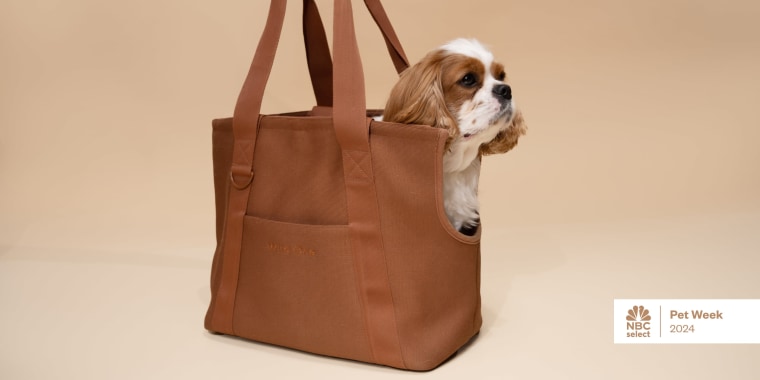
We’re celebrating National Pet Week at NBC Select by sharing our favorite pet products. Shop puppy supplies , kitten essentials and more on our pets homepage .
We all want our dogs by our side as much as possible, and that might include them tagging along on vacations and holiday trips. But traveling with a pet usually involves a range of safety considerations, including gathering the right health paperwork , keeping treats and water on hand and making sure they’re comfortable. Since most airlines and other transportation methods will require taking your dog in some kind of enclosure, the pet carrier you choose is crucial in keeping your dog safe and comfortable.
We spoke to veterinarians, vet technicians and travel safety experts about what to look for in a travel carrier for your dog and how to shop for one that’ll keep them safe. We also compiled a list of carriers either tested by NBC Select staff or recommended by our experts to consider.
SKIP AHEAD Best dog travel carriers | How to shop for a dog travel carrier | How to help your dog feel calm in a travel carrier
Selected. Our top picks

How we picked the best dog travel carriers
When shopping for the best travel carrier for your dog, our experts recommend considering the following factors:
- Size: Pick a carrier that’s big enough for your pet to comfortably stand, sit, lie down and turn around in. The carrier should be as long as the tip of the dog’s nose to the base of the tail, says veterinarian Dr. Kristen L. Nelson . Carriers will usually come in a variety of sizes to fit different breed types (though keep in mind that airline-approved carriers have very specific dimension requirements that will usually only fit small dogs under 20 pounds, according to our experts).
- Materials and build: Carriers are usually soft-sided and made of polyester or nylon, which are easy to clean and water- and tear-resistant, according to our experts. Choose one with mesh sides to provide a good amount of ventilation. Most importantly, you should opt for a carrier that can stand up on its own and not collapse around your pet or deform easily, says Dr. Christina Carlo , a veterinarian and medical director at VCA Avondale Veterinary Hospital. Hard plastic carriers are usually designed for airplane cargo holds, but they’re a safe and durable option for car rides, too, says Carlo.
- Airline requirements: Commercial airlines will usually have certain dimension requirements for carriers that go in the plane’s cabin (with the passenger) and crates that travel in the cargo area of the plane. Most airlines like United Airlines , Jetblue and American Airlines have varying dimension requirements, so be sure to visit their site before traveling.
- Crash testing: Look for carriers and crates that have undergone independent crash testing by the Center for Pet Safety (CPS), which gives your pet the best possible chance of survival if a crash occurs, says Dr. Wendy Hauser , a veterinarian and special advisor to ASPCA Pet Health Insurance.
Best dog travel carriers of 2024
Below are the best dog travel carriers based on experts’ guidance and NBC Select staff experience. We also include top-rated options and key factors to consider, including the carrier’s material, weight capacity and dimensions.
Best overall travel carrier: Away The Pet Carrier
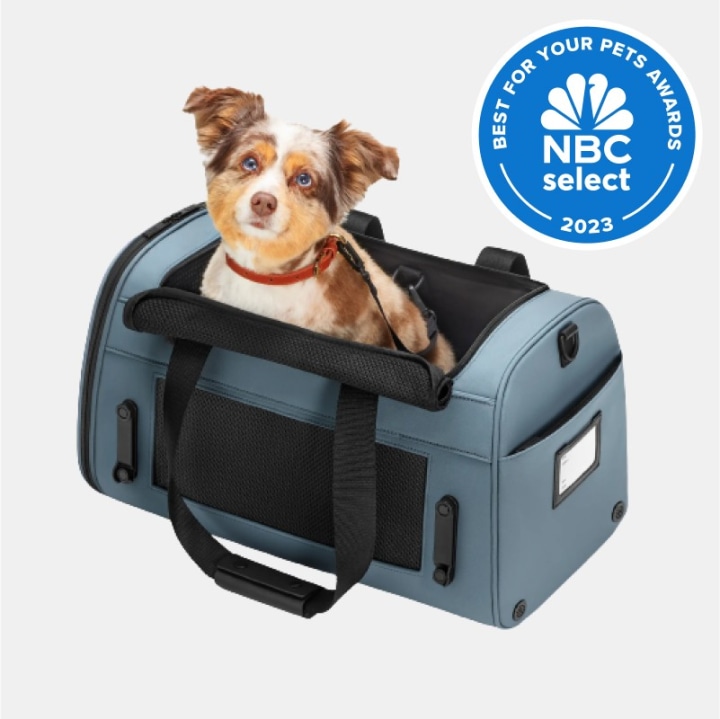
Away Pet Carrier
- CPS certified
- Mesh sides and top
- Removable and washable bedding
- Recommended for smaller dogs
This Away travel carrier, an NBC Select Pet Award for best overall travel carrier, is designed for both car and airline travel. It has zip openings on the top and front with see-through mesh to help your pet see out of the carrier (if you prefer to avoid this, there’s a piece of fabric that rolls down to cover their view).
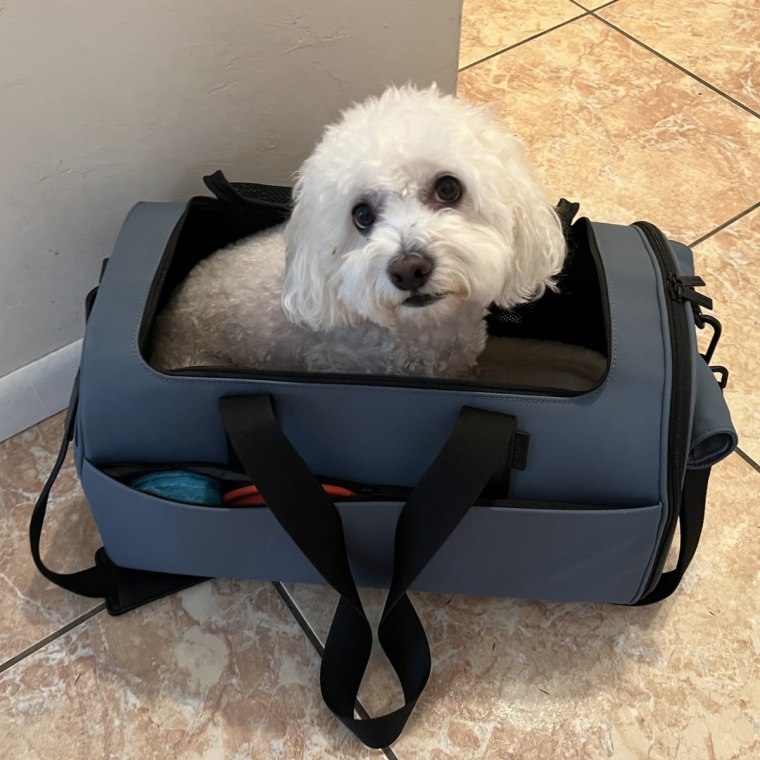
I use this carrier to fly with my 16-pound havanese and bichon frise mix, Bella, because it’s sturdy and makes her feel safe and supported thanks to its durable nylon and leather construction. The mesh gives her enough visibility to know what’s going on outside and helps me keep tabs on her, too. It also comes with machine-washable bedding on the inside that’s soft to the touch, and multiple pockets that keep my belongings and pet essentials accessible during the whole flight. If you’re traveling by car, the carrier has latches on one side that securely fasten to a car’s seat belt system. The Away carrier comes in black and blue colors and you can also personalize it with your initials for an additional $35.
Pet weight: Up to 18 lbs | Dimensions (LxWxH): 18.7 x 10.8 x 10.75 in. | Material: Water-resistant nylon
Best airline-approved carrier: Sherpa Pet Carrier
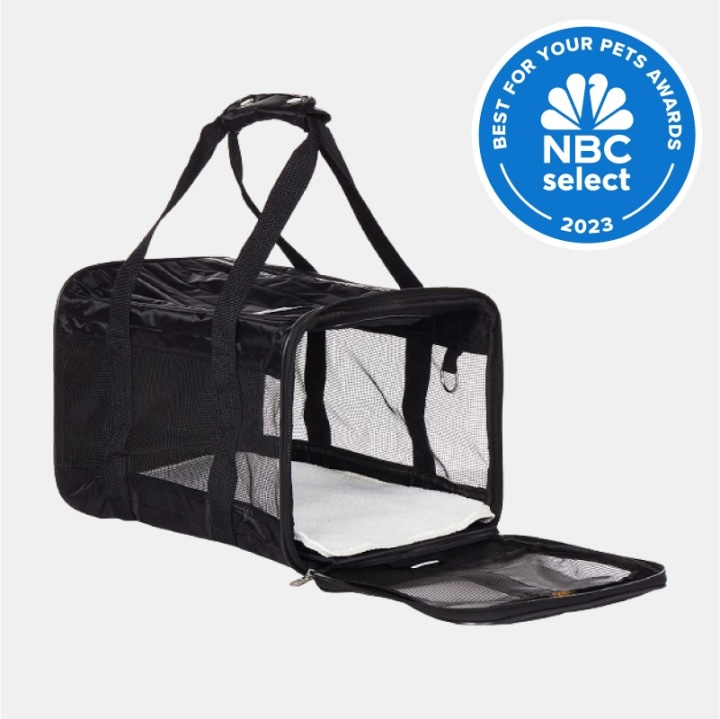
Sherpa Original Deluxe Pet Carrier
- More affordable option
- Very well ventilated
- Removable and washable liner
- Recommended for smaller pets
Another NBC Select Pet Awards winner, this Sherpa carrier is a favorite of CPS founder Lindsey Wolko, who has used it for years to travel with her own pets. She specifically recommends it for air travel because it fits under the passenger seat (it meets the dimensions for most airlines, but always check your specific airline’s requirements before traveling) and has a large zip pocket to store pet supplies like water bowls, leashes and treats. However, it’s not the best pick for car travel because you can’t strap it in using your vehicle’s seat belt system — you’re better off placing it on the floor behind the driver’s seat for safety and to avoid the stitching or zippers to fail, says Wolko.
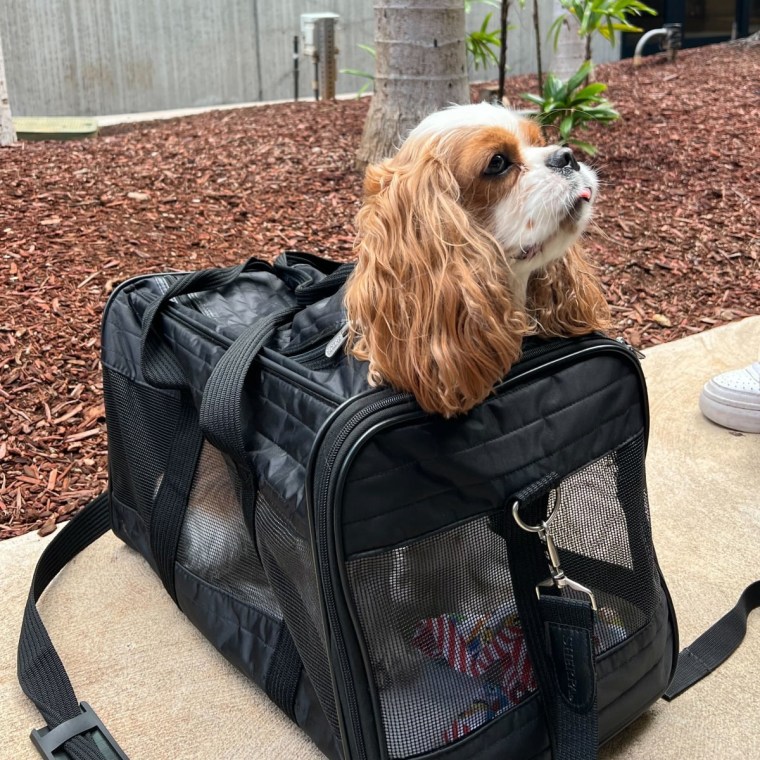
NBC Select manager of editorial operations Shari Uyehara uses this carrier to fly with her 20-pound cavalier King Charles spaniel, Loki, and says it’s a great affordable option. Loki can comfortably shift positions during the flight, and the carrier itself is structured enough to maintain its shape while under the seat, says Uyehara. The sides are made of see-through mesh that allows your pet to easily see out of it. Available in medium and large sizes, the carrier also has shorter top handles and a longer shoulder strap to fit your carrying preferences.
Pet weight: Up to 16 lbs | Dimensions: 17 x 11 x 10.5 in. (medium size) | Material: Polyester and mesh
Best hard-sided carrier: Gunner Kennel G1
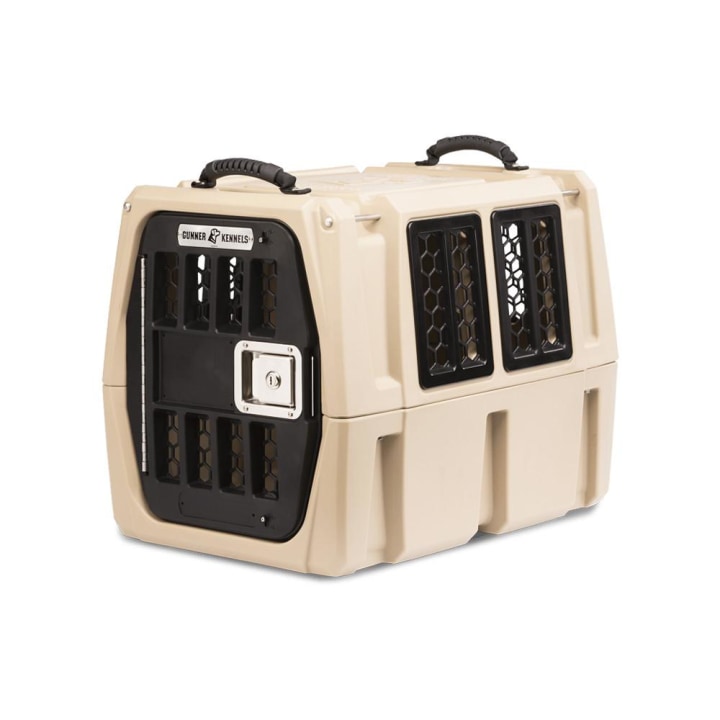
Gunner Kennel G1
- Can't be used as carry-on
This crate earned a 5-star safety rating from the CPS in both the crate and carrier class (the only product to earn a dual certification), and it’s a favorite among our experts. The crate has a thick exterior layer for impact protection, which keeps your pet safe if there’s a crash or a fall, according to the brand. Its reversible door design with an aluminum frame lets you open the crate from either side, and won’t pop open in the middle of a flight, according to the brand. It comes in four sizes — small, medium, intermediate and large — and Gunner offers a size guide that gives recommendations based on your dog’s weight and length.
Pet weight: Up to 30 lbs for small, up to 45 lbs for medium, up to 75 lbs for intermediate and up to 110 lbs for large size | Dimensions: 24.5 x 18.625 x 19 in. (small), 29.5 x 20.5 x 23.5 in. (medium), 34 x 23 x 28.5 in. (intermediate), 40.25 x 28 x 33.25 in. (large) | Material: Reinforced aluminum frame
Best soft-sided carrier: EliteField Soft-Sided Dog & Cat Carrier Bag
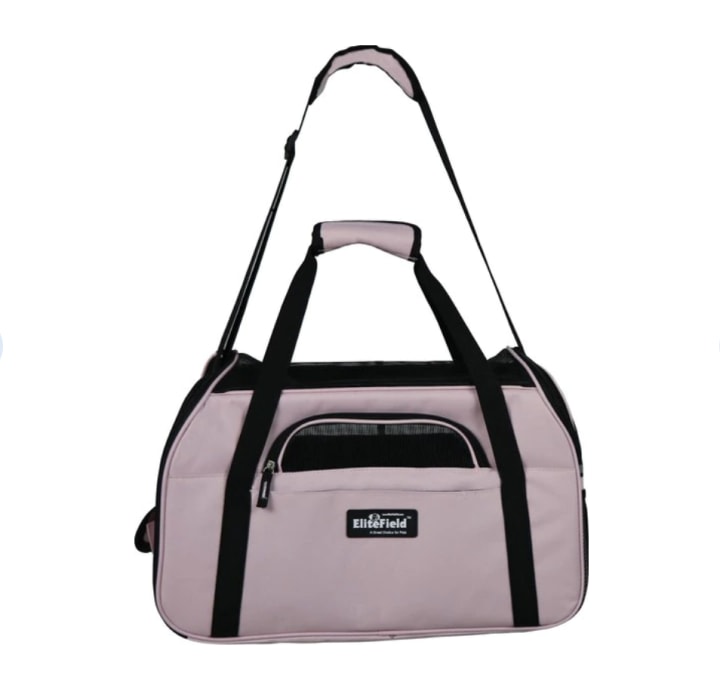
EliteField Soft-Sided Dog & Cat Carrier Bag
At just over two pounds, this is the most lightweight soft-sided pet carrier on our list. It comes recommended by Dr. Amber Karwacki , a veterinarian and partner doctor at Heart + Paw in Callowhill, Pennsylvania, because it has mesh panels on both sides and the front to let air in and prevent your pet from overheating, according to the brand. It also comes with removable and machine-washable bedding and has a back sleeve that attaches to your suitcase, as well as loops that latch onto your car’s seat belt system. The polyester and synthetic build is water-resistant and available in six colors to fit your personal style.
Pet weight: Up to 18 lbs | Dimensions: 19 x 10 x 13 in. | Material: Polyester
Best tote carrier: Wild One Everyday Carrier
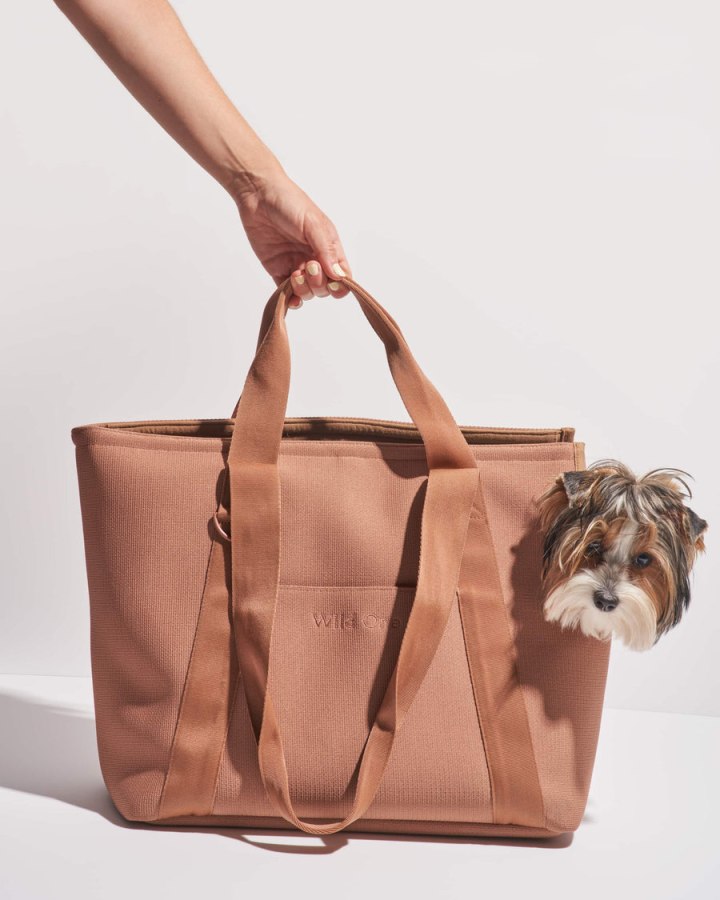
Wild One Everyday Carrier
- Remains open
If you’re looking for a tote to carry your dog around town or on the train, consider this Wild One carrier. This NBC Select staff-favorite option has a small dip in its design, which allows your dog to peek their head out while you carry them around. “I love that Loki’s weight remains balanced in the carrier, but he still has room to move around,” says Uyehara, who appreciates its stability. It also includes a safety clip that attaches to your dog’s harness, ensuring they won’t jump out at a bad time, according to Karwacki (but be sure to never connect this clip to their collar since it poses a choking hazard). It also comes with carrying straps of two different lengths — one for carrying it like a shoulder bag, and shorter straps to carry it by hand. There is a machine-washable mat on the inside and three exterior pockets to hold all your pet’s essentials like bags, treats and toys.
Pet weight: Up to 20 lbs | Dimensions: 21.5 x 7.5 x 14.25 in. | Material: Recycled polyester outer, cotton interior
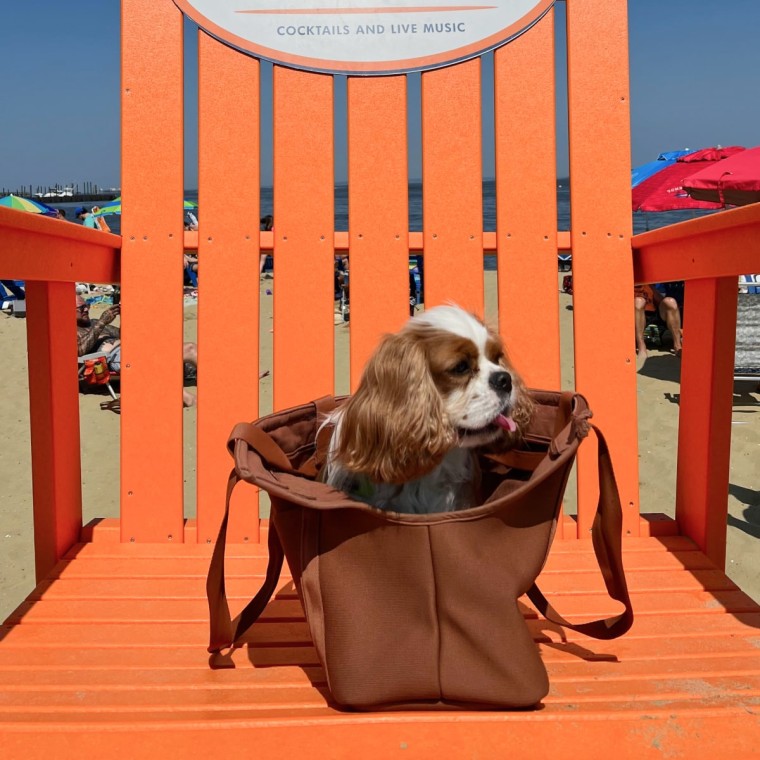
Best collapsible carrier: Roverlund Out-Of-Office Pet Carrier
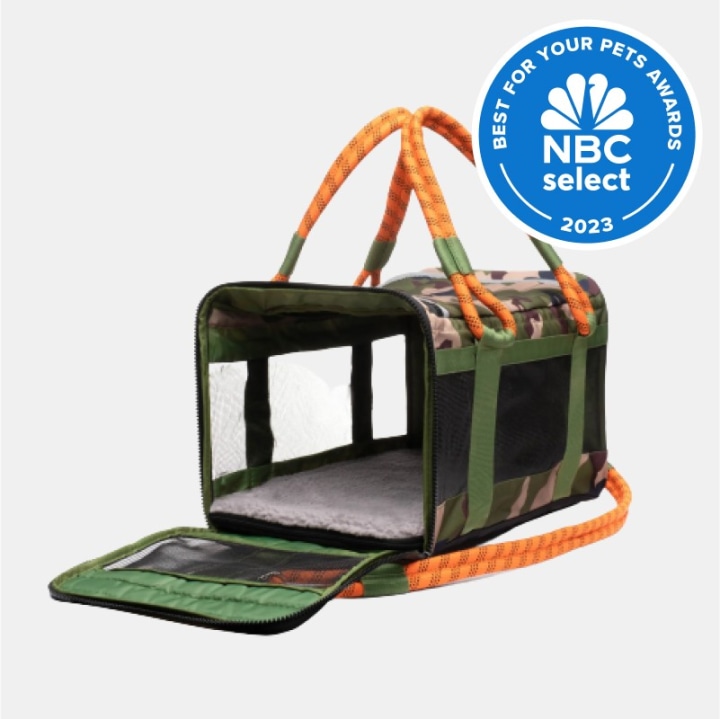
Roverlund Pet Carrier
An NBC Select Pet Awards winner, the small version of this Roverlund carrier is an airline-approved option for both dogs and cats because it’s less than 18 inches long. The straps are all ropes, which our staff found to be more comfortable and supportive than other carrier straps made from typical polyester or fabric. The interior lining is machine-washable and you can also shop the larger version of this carrier for dogs up to 25 pounds.
Pet weight: Up to 20 lbs | Dimensions: 17 x 11 x 10.5 in. (small size) | Material: Water-resistant polyester, mountain climbing rope
Best backpack carrier: Apollo Walker Pet Carrier Backpack
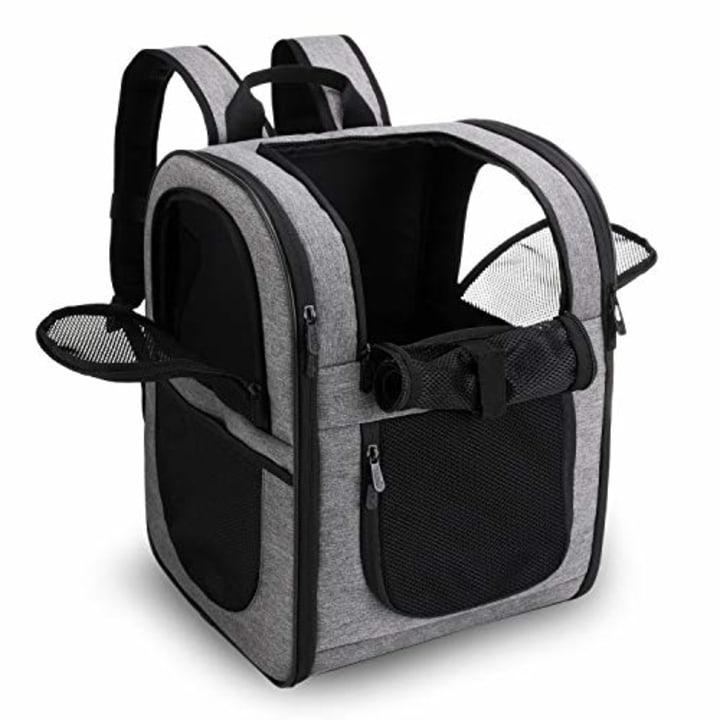
Apollo Walker Pet Carrier Backpack
- Adjustable straps
- Pet can see outside
This highly rated backpack carrier, which has a 4.6-star average rating from over 4,900 reviews on Amazon, has shoulder straps and two separate straps that buckle around your sternum and waist to help evenly distribute the weight of your pet, according to the brand. It has mesh panels on all sides to let your pet see out and comes with removable fleece bedding to keep them comfortable while creating a sturdy base that can hold their weight, according to Apollo. It also comes with a clip that attaches to your pet’s harness to prevent them from escaping or falling out.
Pet weight: N/A | Dimensions: 12.6 x 11.4 x 16.8 in. | Material: Polyester
Best expandable carrier: Midwest Duffy Dog & Cat Carrier
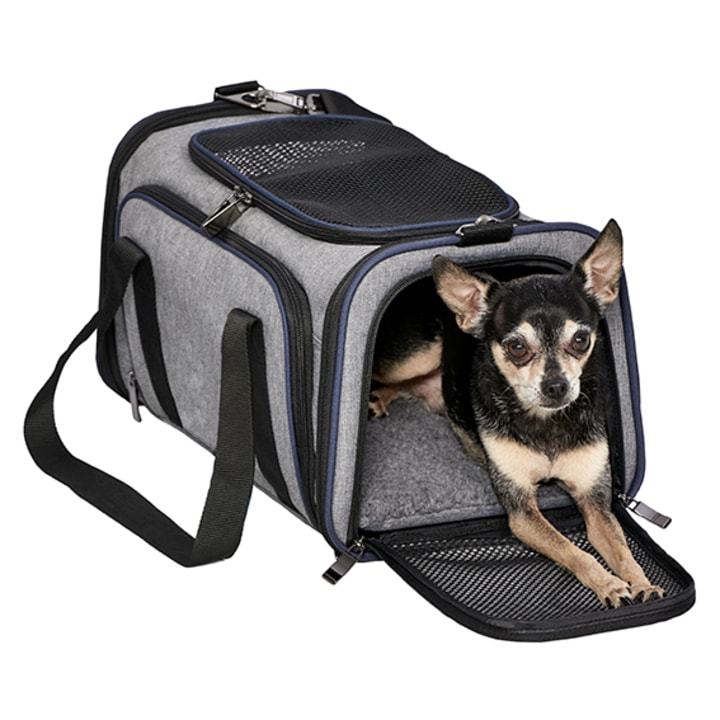
MidWest Duffy Dog & Cat Carrier
- No removable bedding
- Not as ventilated as others
This Midwest Duffy carrier comes recommended by Karwacki because it’s expandable — the mesh sides open up to give your pet more room to move around and stretch their legs. It has two zippered side openings, as well as one on top to make taking your dog in and out easier, according to the brand. It also folds completely flat, so you can store it away when it’s not in use. It comes in three colors and sizes small, medium and large.
Pet weight: Up to 15 lbs | Dimensions: 16.3 x 10.1 x 9.3 in. (small), 18.3 x 11.3 x 11.1 in. (medium) and 19.3 x 12.2 x 12.2 in. (large) | Material: Polyester
Best for medium-sized dogs: Arlo Skye The Pet Carrier
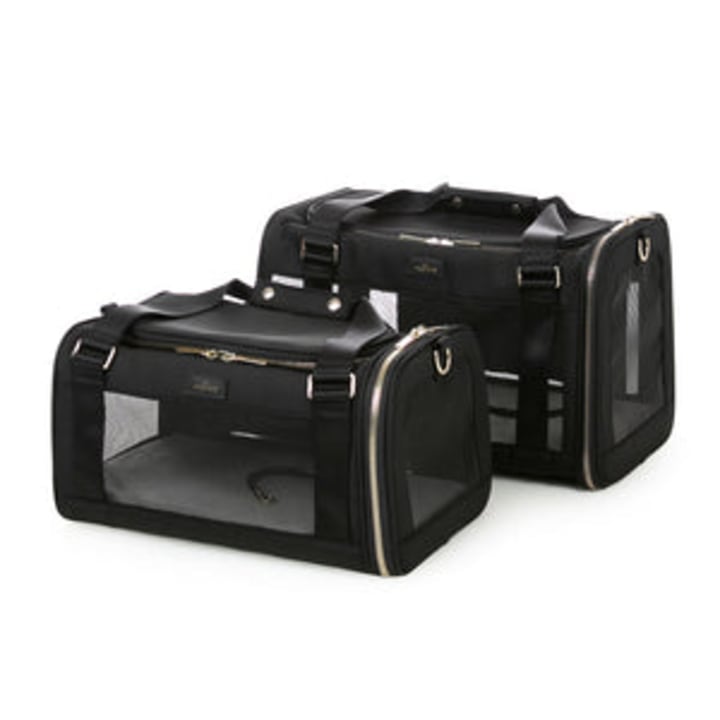
Arlo Skye The Pet Carrier
- No mesh top
This Arlo Skye pet carrier has mesh panels on all sides, making it a well-ventilated option for your pup. It comes with memory foam bedding on the inside that’s both removable and machine-washable, as well as a foldable design you can pack easily in your suitcase or travel bag, according to the brand. It has dual openings on both ends and a back trolley sleeve to place it over your carry-on . The carrier is also highly rated with a 4.9-star average rating from over 60 reviews at Arlo Skye.
Pet weight: Up to 25 lbs | Dimensions: 17.5 x 11 x 10 in. | Material: Poly-mesh and nylon
Best for small dogs: Sleepypod Mobile Pet Bed
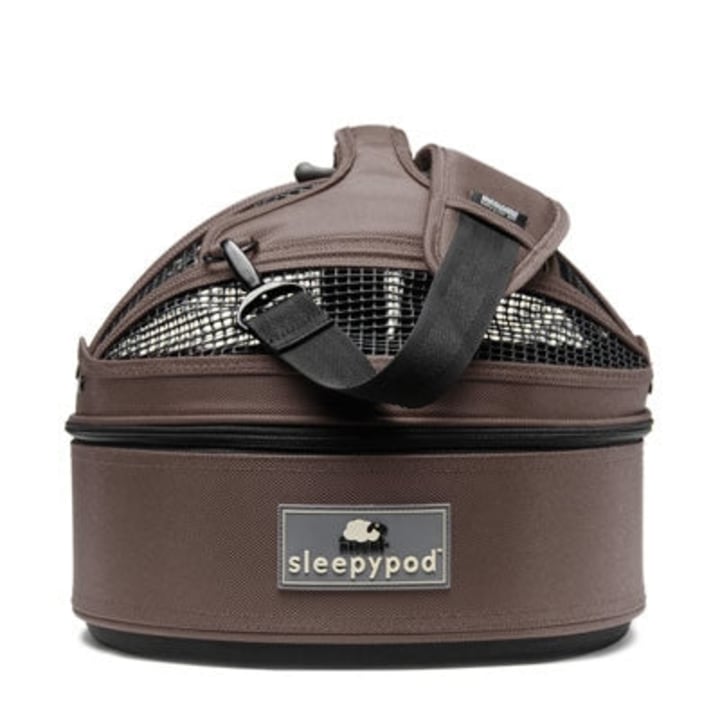
Sleepypod Mobile Pet Bed
The Sleepypod Mobile Pet Bed is an expert-recommended and CPS-certified option that has breathable mesh and a machine-washable interior — it’s built for plane travel for dogs under 15 pounds. Nelson recommends the Sleepypod because it’s easy to carry and gives the pet privacy while traveling since it’s fully enclosed with a mesh panel at the top.
Like several other carriers on this list, the Sleepypod isn’t limited to airline travel: It straps into a vehicle’s seat belt system, so you can comfortably take road trips with your pet. You can also separate the bottom of the carrier to transform it into a bed for your pet, which makes training easier since they can form a positive association with it, says Wolko. The brand’s Sleepypod Atom is another CPS-certified carrier that’s crash-tested for even smaller dogs up to 12 pounds, the lowest weight requirement on this list.
Pet weight: Up to 15 lbs | Dimensions: 17 in. (D) x 6.5 in. | Material: Polyester
Best lightweight carrier: Molly and Stitch Alpine Dog Carrier
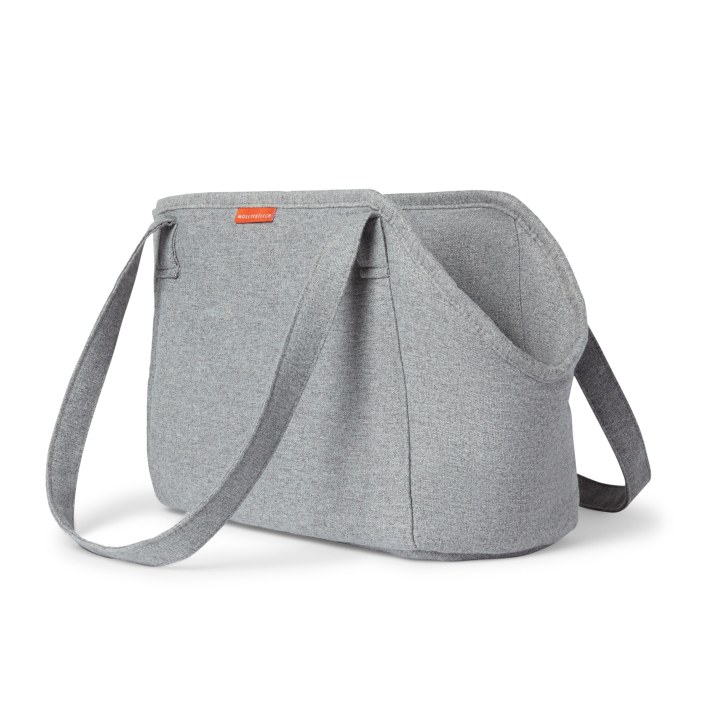
Molly and Stitch Alpine Dog Carrier
- Stylish design
- Padded and comfortable
- Machine-washable
- Not for plane travel
This tote carrier is great for smaller dogs, and its lightweight design is convenient to take anywhere. It's a favorite of NBC Select social commerce editor Sadhana Daruvuri, who says her 2-year-old maltipoo Bandit fits comfortably inside. “This carrier is very high quality, and it was so stylish that I would happily use it as an everyday bag,” says Daruvuri. “Cleaning it is also easy — you can just throw it in the wash, and even after repeated uses, the bag looks brand new.”
Pet weight: Up to 15 lbs | Dimensions: n/a | Material: n/a
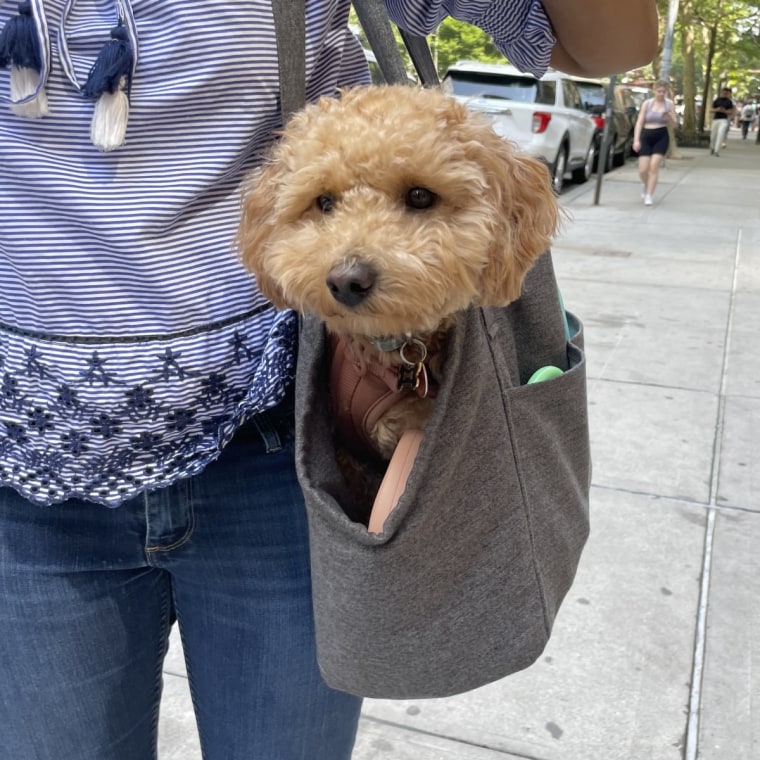
Best carrier with pee pad: Diggs Passenger Travel Carrier
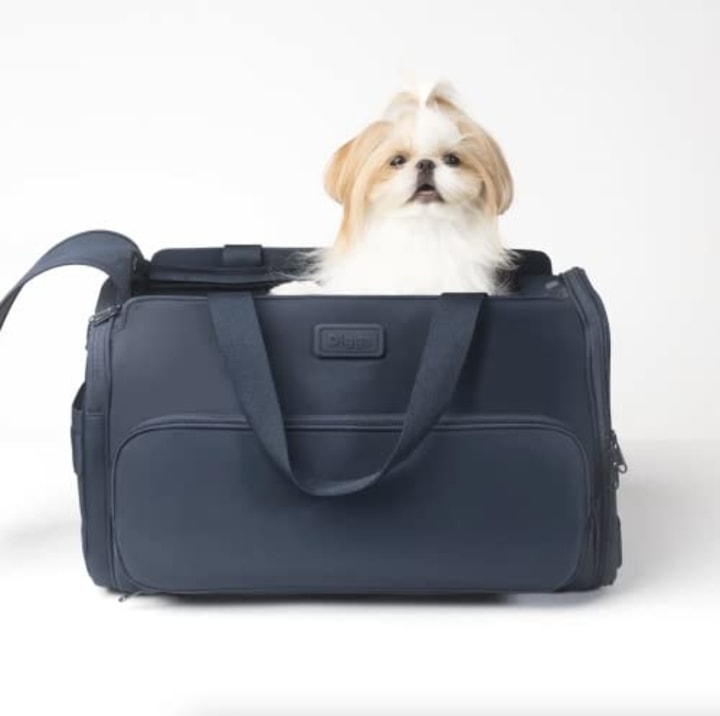
Diggs Passenger Travel Carrier
- Includes a bed and pee pad
- Has multiple pocket
- Not as much mesh as others
Diggs is an NBC Select Pet Award -winning brand that makes some of our favorite dog crates. The brand’s Passenger Travel Carrier is great for both plane and car travel: It fits many airlines’ size requirements, and it has custom seat belt clips and a buckle strap to place it safely in your car. It also comes with a Diggs Pee Pad that attaches to the included bed — if your dog chooses to use it, you can open the side panel to swap it out without disrupting your pup, according to the brand.
Pet weight: Up to 18 lbs | Dimensions: 20 x 11.5 x 10.8 | Material: n/a
Best personalizable carrier: Paravel Cabana Pet Carrier
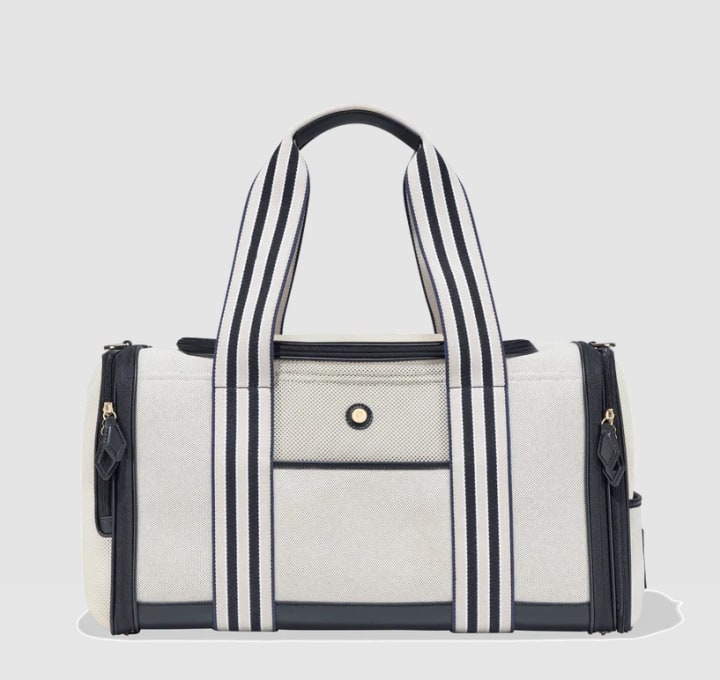
Paravel Cabana Carrier
- Personalizable with name
- Folds flat for easy storage
If you’re looking for a personalized option, this Paravel pet carrier — which is the dog-friendly version of the brand’s original Cabana Tote — lets you monogram your pup’s name or initials in the color of your choosing. It also has a washable fleece interior lining, comes with several pockets for storing treats and other small essentials, and it folds completely flat for easy storage.
Pet weight: Up to 20 lbs | Dimensions: 11 x 20.5 x 11 in. | Material: Paravel EcoCraft Canvas, vegan leather
Best sling carrier: Tomkas Dog Sling Carrier
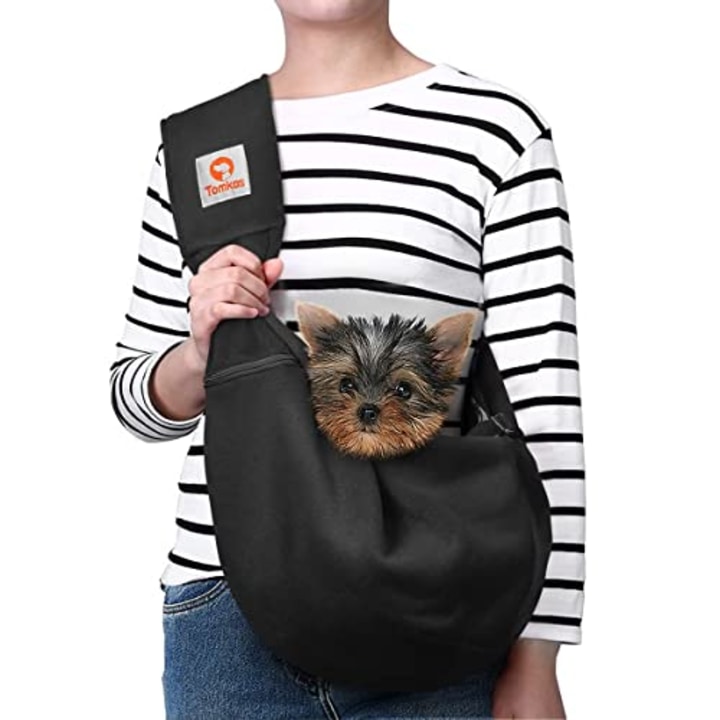
Tomkas Dog Sling Carrier
- Easy to take on the go
- Zip pockets for small items
- Requires physical strength
Designed for small dogs up to 10 pounds, this sling carrier crosses over your body so you can take your dog around town hands-free. The base has a built-in drawstring that adjusts the size of the opening to fit different sized dogs, and the crossbody strap length is also adjustable to fit your comfort level. The carrier includes a safety buckle inside that connects to your dog’s harness to prevent them from falling out, according to the brand. I purchased this carrier for my dog Bella when she was a puppy, and I was able to comfortably carry her around when she got tired of walking. It held her weight well without tearing or damaging the fabric, and the crossbody strap caused less strain on my back.
Pet weight: Up to 10 lbs | Dimensions: 9 x 6 x 3 in. | Material: Polyester
How to shop for a dog travel carrier
Carriers and crates are the most secure type of enclosure when traveling with your dog because they prevent them from escaping and minimize distraction while you’re traveling (especially while driving), says Wolko. But the right carrier for your dog will depend on what type of trip you’re taking, your method of transportation and their temperament.
When shopping for the right carrier for your dog, our experts recommend considering the size and fit of the enclosure, whether it’s crash-tested, if it meets airline requirements and more.
Your dog or cat should be able to easily stand up, turn around and lay comfortably in their carrier. That means the length of your carrier from front to back should measure about the same, or one or two inches more than the tip of your dog’s nose to the base of their tail, says Nelson. You should add a few more inches for brachycephalic breeds like pugs, pekingese and French bulldogs, though experts don’t recommend taking these breeds on flights because their shorter noses increase the risk of overheating and oxygen deprivation, says Nelson (some airlines even ban this breed from flying in the cargo hold , according to the American Veterinary Medical Association). To determine the right height of your carrier, make sure it measures the same or larger than the height of your pet from the floor to the top of their shoulders, says Carlo.
Place a mat or bed in the carrier to make the space more comfortable for your pet, says Carlo (though you should avoid this if your dog usually destroys their bedding because they might eat the pieces and cause intestinal obstruction). Putting soft blankets or their favorite toy in the carrier can also help them feel familiar and safe, according to our experts.
Whether your dog can see out of their carrier is a matter of personal preference, though our experts recommend mesh so the outside is visible, which prevents your dog from feeling threatened or confused while they’re traveling, says Wolko.
Materials and structure
Most carriers are soft-sided and made from materials like polyester, mesh and nylon fabric. Consider whether the carrier has structure, meaning it can stand up on its own and won’t automatically collapse around your pet, according to Carlo. You should also look for carriers that have pockets, so you have room for your pet supplies.
You can take a hard-sided, non-collapsible crate or kennel on an airplane, but they must be able to fit under the passenger’s seat, according to Hauser (this might be harder to do compared to soft-sided carriers since they don’t mold to a different size). Plastic hard-sided crates are usually good for transporting your pet in an airplane cargo hold and the cargo area of a car — they’re considered to be the safest option since they won’t lose their shape and provide impact protection in case of a crash, turbulence or hard fall, according to our experts. However, you should avoid metal wire crates because pets might be able to stick their feet or limbs out, which can be a safety hazard while traveling, says Karwacki.
Safety considerations
For car travel, look for carriers and crates that have undergone crash testing by the Center for Pet Safety, a registered nonprofit and advocacy organization that crash tests car restraints and containment devices. This provides an extra layer of safety when traveling with your pet, our experts say.
“Most carriers on the market only prevent distractions [for the driver], which is important, but in a crash, they may not perform as you would expect them to,” says Wolko. The CPS certification tests carriers as an unaffiliated third party. This is important when considering that many brands subjectively “pass” their carriers if they test them in their own labs, which can ultimately give pet owners a false sense of security, according to Wolko.
Though the CPS does not specifically test carriers and crates for airline travel, you can use most carriers that meet the airline’s size requirements and have ample ventilation, according to Wolko.
A CPS-certified crate usually has backup door latches and locking mechanisms to prevent your pet from escaping, which is especially useful if they travel in the aircraft’s cargo hold. “So, if something tumbles, the kennel is so robust that the pet is not getting out,” says Wolko. Most airlines have certain regulations for what carriers to use when transporting an animal in the cargo area of a plane. The International Air Transport Association, a globally recognized trade association for the world’s airlines, details specific requirements for crates to transport animals in the cargo hold, including construction and adequate ventilation (more on that below).
Frequently Asked Questions
For air travel, always check with your airline to see what type and size of carrier it allows. The approved dimensions of your carrier vary from airline to airline but, in most cases, carriers can’t exceed 11 inches in height, which allows it to fit under the seat in front of the passenger, according to Hauser. Also, the carrier will likely count as your carry-on luggage on most airlines, and in-cabin travel will usually require you to make a reservation or reserve a seat specifically for your dog.
Certain airlines might also have specific pet size and weight requirements for in-cabin travel. Typically, pets must weigh 20 pounds or less, though this varies by airline, and most larger dogs can’t ride in-cabin unless they’re a trained service animal, says Wolko. If your pet exceeds that limit, they’ll need to travel in the cargo area of the plane.
Most airlines will allow trained service dogs on board at no cost. However, some airlines like Delta Air Lines, Southwest, American Airlines and Alaska Air are no longer accepting emotional support animals on board.
Carriers and crates for dogs are usually used interchangeably, but there are a few key differences. The CPS defines crates as enclosures that are secured in the cargo area of a plane or tethered securely to the floor of a vehicle like a van or SUV. They’re usually constructed of thick molded plastic or metal and designed for larger dogs, according to our experts.
Carriers, on the other hand, are usually designed for smaller dogs and made of a soft-sided fabric (though some are constructed of a harder plastic or nylon to prevent them from collapsing on your pet). When traveling in a car, the carrier usually goes in the backseat and is strapped in using the seatbelt system of your vehicle.
Yes, it is generally safe and common to travel with your dog in the cargo hold (also known as the lower deck) of an airplane, which also holds baggage. However, experts recommend only flying your pet in the cargo hold when it’s absolutely necessary because it can be a very stressful experience for them.
“There’s a lot of weird noises, not much light down there — it’d be scary for anyone to go in the [cargo hold], ” says Karwacki. And, most handling risks come before they even board the plane: Dogs usually endure the most force when being transported across the rough, uneven tarmac to get to the plane, says Wolko.
The International Air Transport Association (IATA) lists specific requirements for crates, including construction and ventilation, to keep your pet safe when flying in the cargo hold. For example, the trade association specifies that crates must be sturdy and inescapable and adequately ventilated on three sides, with the majority of the ventilation being provided on the upper part of the container.
Most aircraft cargo holds are temperature-controlled and pressurized, according to the U.S. Department of Agriculture . Animals can’t be exposed to temperatures above 85 degrees Fahrenheit or below 45 degrees Fahrenheit for more than 4 hours, per the USDA’s website. Most airlines won’t transport dogs altogether if ground temperatures reach those extremes.
How to help your dog feel calm in a travel carrier
Your pet’s comfort level in their carrier can determine how smooth your travels are. Below, we list a few expert tips about how to get your dog adjusted to their carrier and how to keep them comfortable during long trips.
- Know your dog’s safety and security preferences. Some dogs prefer more open-sided kennels with better airflow and visibility, while others feel safer with the cave-like security of a molded plastic carrier with smaller windows, says Hauser.
- Make the carrier or crate their “happy spot.” Allowing your pet to build a positive association with their carrier helps them feel calm and safe while traveling, according to our experts. In your home and before traveling, leave the door open so that your pup can explore the enclosure on their own terms, which demystifies it, says Hauser. After some time, it isn’t uncommon to find pets that preferentially sleep in their enclosures,” she says. Once they get acclimated to the crate or carrier at home, you can then graduate to car trips and, later on, plane rides. Start off with brief trips that increase in duration over time.
- Make the carrier feel familiar. As we mentioned, putting their favorite bed, blankets or toys in the carrier can help make them feel more comfortable.
- Avoid any safety risks while on the plane. For example, if you’re traveling with your pet in-cabin, never put the carrier in the overhead compartment of the plane with your pet inside because it poses a suffocation risk, says Wolko. Also, feed your pet before you get on the plane — if they choke or get something lodged in their throat while you’re in the air, they likely won’t get help in time, according to Wolko.
Meet our experts
At NBC Select, we work with experts who have specialized knowledge and authority based on relevant training and/or experience. We also take steps to ensure all expert advice and recommendations are made independently and without undisclosed financial conflicts of interest.
- Dr. Kristen L. Nelson is a veterinarian and author of “Coated With Fur: A Vet’s Life.”
- Dr. Christina Carlo is a veterinarian and medical director at VCA Avondale Veterinary Hospital.
- Dr. Wendy Hauser is a veterinarian and special advisor to ASPCA Pet Health Insurance.
- Lindsey Wolko is the founder of the Center for Pet Safety , a registered nonprofit and advocacy organization that crash-tests car restraints and containment devices for pets.
- Dr. Amber Karwacki is a veterinarian and partner doctor at Heart + Paw in Callowhill, Pennsylvania.
Why trust NBC Select?
Mili Godio is an updates editor at NBC Select who covers a variety of pet topics, including dog food , beds , treats and toys . For this article, Godio spoke to five veterinarians and pet safety experts about the best carriers for your dog and how to safely travel with them. She also compiled experts' recommendations for the best travel carriers to consider, as well as travel carriers tested and reviewed by NBC Select staff.
Catch up on NBC Select’s in-depth coverage of personal finance , tech and tools , wellness and more, and follow us on Facebook , Instagram , Twitter and TikTok to stay up to date.
Mili Godio is an updates editor for Select on NBC News.

IMAGES
VIDEO
COMMENTS
Victoria is the most pet-friendly state of Australia when it comes to allowing pets on public transport. While most Australian states ban all pets from public transport or just allow pets onboard in limited scenarios (such as small pets in carrier bags on buses), Victoria frequently allows pets onboard public transport services.
Try some in-tents bonding at Johanna Beach and Lake Elizabeth, Great Otway National Park; Jerusalem Creek, Lake Eildon National Park; Shoreline Drive, Gippsland Lakes Coastal Park; Lake Hindmarsh Reserve, and Howqua Hills Historic Area, Mansfield. For more creature comforts, curl up in a pet-friendly cottage, holiday house or apartment.
Thetis Lake National Park. Dog Friendly Patios in Victoria. The Drake Eatery (Best Patio Vibe) Tug Eatery and Bar (Best Patio Views) Nourish Kitchen and Cafe (Best Patio Brunch) Beagle Pub (Best Patio Comfort) Dog Friendly Hotels in Victoria, BC. Fairmont Empress. Coast Victoria Hotel and Marina.
Dog-friendly Victoria. Make space for a break with your best mate. Here in regional Victoria, there's space to chase waves and frisbees, and there's sticks and balls to fetch. There's places to set free all your wags and wiggles - until you're all tuckered out. Victoria's your best friend's paw-fect place. Fur real.
Take a holiday with your dog in Victoria. Don't leave your pet behind when you go away. Find somewhere to stay together for you and your dog when on holidays. Choose from over 300 properties of various styles all over Victoria that offer dog friendly accommodation for you and your best friend. Book direct with the accommodation property and save!
Address: Waverley Road, Wheelers Hill VIC 3150. Escape the hustle and bustle of city life and immerse yourself in the serene beauty of Jells Park. This expansive park is a paradise for both dogs and their owners, providing ample space for leisurely walks, games of fetch, and picnics.
Don't terrier self-up about it. Chateau Victoria Hotel & Suites makes visiting Victoria with your dog easy-peasy. This locally owned and operated hotel offers both dog-friendly traditional and one-bedroom suites. For a pawsitively perfect stay for your pooch, the Chateau provides doggy amenities including towels and wipes, treats, bowls and ...
7. Mansfield Coffee Merchant. Grab a great, local roast coffee and dine al fresco with your dog. There's an all-day menu, and the fresh produce is locally sourced. 8. Mansfield State Forest. Take a dog-friendly forest walk on the Plain Creek Loop, by the Delatite River. Start at Carter's Mill Day Reserve.
Victorian Dog Friendly Airbnbs: With so many city, country, and coastal treats on offer, you're never far from a good time in Victoria. Our favourite places to holiday with your dog include: A renovated beach house in Rye from $300 per night; An industrial conversion in Wilsons Prom from $471.43 per night; A private bungalow in Bittern from $136.57 per night
With a variety of activities, the Macedon Ranges prove to be a destination, rather than a one-day pit stop. Two of the best dog-friendly hike options are the Camels Hump to Picnic Ground walk — which includes a walk over Macedon's highest peak — and a 2.5-kilometre trot around Sanatorium Lake. The seven best spots to camp, hike and swim ...
5. Grampians Getaway. Stay with your doggie companion in one of six unique 'pyramids', architecturally designed to harmonise with the tranquil surrounding landscape. Sleep soundly on 50 acres of native vegetation right at the foothills of the Grampians. Onsite dam gets two paws up for paddling! 6. Gariwerd Motel.
2. Johanna Beach Campground. Address: Red Johanna Rd, Johanna VIC 3238, Australia Need to Know: Booking Required: Yes, to secure a spot. Dog Policy: Dogs on leash are allowed in certain areas. How to book: For more information or to book, visit the Parks Victoria website here. Facilities: Toilets, non-flush; bring your own water. Dog-Friendly Features: Johanna Beach Campground is known for its ...
Join Australia's most trusted pet friendly accommodation site and access our many loyal guests. Share your love of holidaying with dogs with others and receive property bookings at the same time. Receive guest reviews and be in the running to win a F ive Paws Award celebrating Australia's best pet friendly accommodation.
Tips for Hiking with Dogs in Victoria. Most regional parks and trails are dog-friendly, but some are on-leash only or have seasonal restrictions. ... Top Travel Tips & Resources for Victoria, BC. Travel Insurance - If you're travelling internationally, travel insurance is a must for any trip. Being covered by insurance is especially ...
Pets on Black Ball Ferry, Port Angeles to Victoria. Pets are allowed on the deck of the ferry. Since dogs and cats can travel for free on the ferry, it is a great and easy way to get back and forth between Vancouver Island and Washington State. Whether you are going on vacation, relocating, or just want to pop over for a day trip, you don't ...
Dogs can travel in the cabin of the car or behind a cargo barrier in the back of wagon or SUV type vehicle. ... The law in Victoria requires that dogs on utes are restrained either via a tether or cage, so that the dog cannot fall off or be injured when the vehicle moves. The only exception is for dogs that are actively working livestock.
Pets are part of the family, so we want them to travel as comfortably as possible. Small pets including dogs, cats, ferrets, birds and hamsters are all welcome and travel for free. Important: All animals (except guide and service animals) must remain in your vehicle or in a designated Pet Area. For more information about travelling with a guide ...
FILE - A traveler pulls his dog in a wheeled carrier at the Benito Juarez International Airport in Mexico City, Wednesday, Dec. 21, 2022. If you are bringing a dog into the U.S. — whether if you ...
Traveling internationally with a dog — or adopting one from abroad — just got a bit more complicated. The CDC issued new rules intended to reduce the risk of importing rabies.
Travel Checklist for foreign-vaccinated dogs from high-risk countries; 60-90 days (or more) before travel: Verify the dog will be at least 6 months old on day of arrival in the United States. Get the dog microchipped or have a veterinarian verify its microchip number. Make sure the microchip number is listed on all veterinary records.
More people travel internationally with their pets, and more rescue groups and breeders have set up overseas operations to meet the demand for pets, she said. Now, about 1 million dogs enter the U ...
FILE - A traveler pulls his dog in a wheeled carrier at the Benito Juarez International Airport in Mexico City, Wednesday, Dec. 21, 2022. If you are bringing a dog into the U.S. — whether if you are returning from a trip overseas with Rover, visiting the U.S., or adopting a dog from abroad — you have to follow a set of new rules released by the Centers for Disease Control and Prevention on ...
Dog rabies was eliminated in the United States in 2007, but the virus remains endemic in more than 100 countries, according to the CDC, and unvaccinated dogs can still contract the disease from ...
Shop the best dog travel carriers and crates for planes, cars and trains. Browse airline-approved and everyday carriers from Away, Sherpa, Wild One and more.